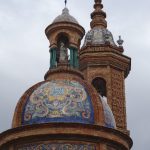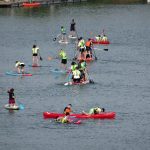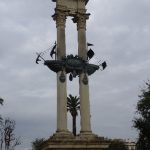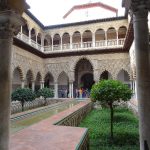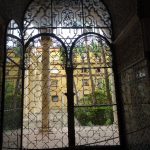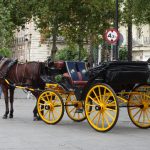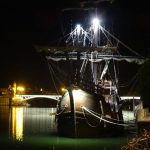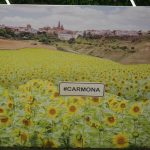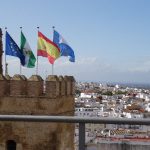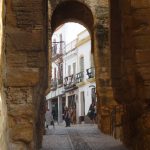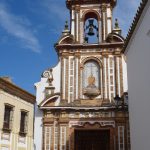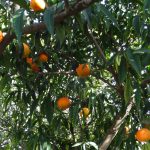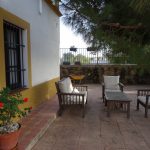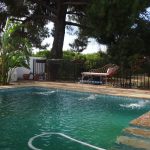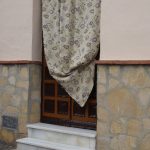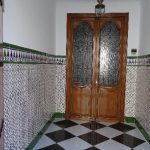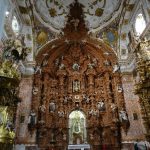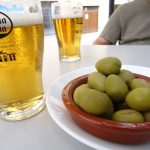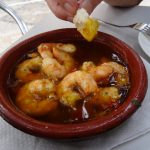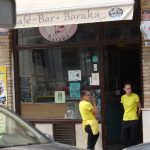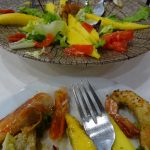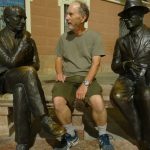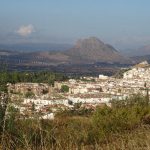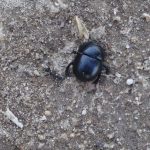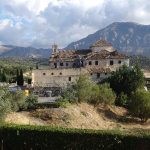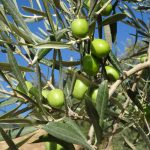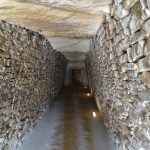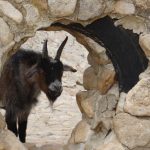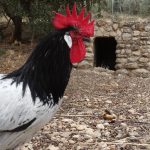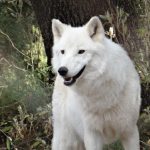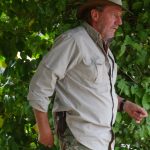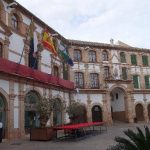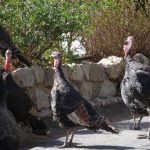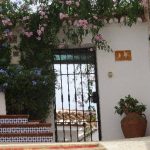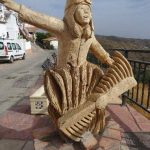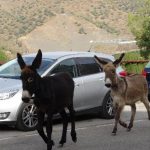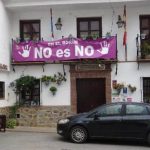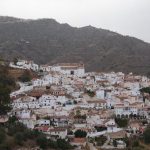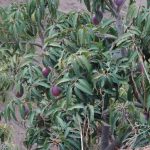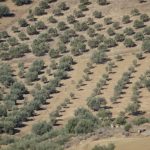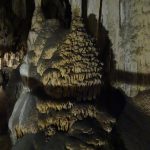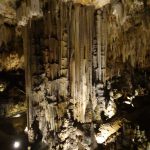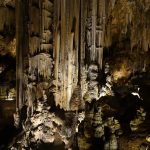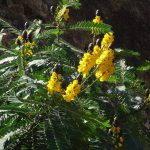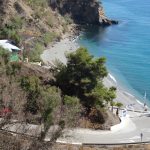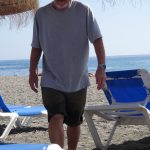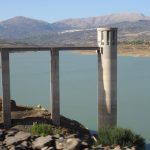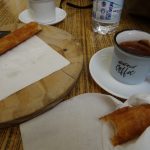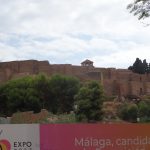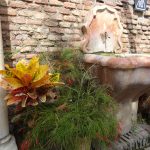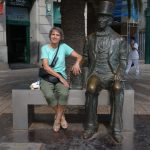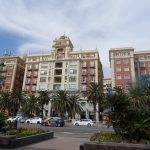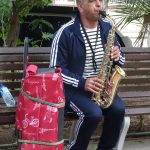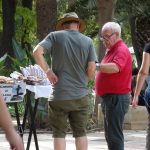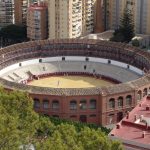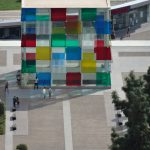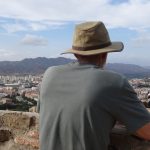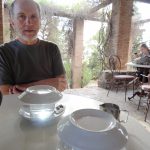-
Flamenco and Mountain Villages
Just outside Seville are the Roman ruins of Italica. Worth a visit, we thought. Signage was pitifully lacking and when eventually located, everything was behind barricades … seemingly stopped mid restoration. With a bit of careful aiming between the chain link fence, we managed a few photos.
There was plenty of time before our check-in at Jerez, so with Cadiz quite close, we took a run down to the coast. The white, sandy beaches, pale blue ocean and palm trees looked very tropical … there were a few people swimming, but a toe dip determined it to be far too chilly to be enjoyable. For us anyway.
A late lunch overlooking the ocean seemed like a good idea … tall glasses of freshly squeezed orange juice and a flame-charred pizza straight from the oven, covered with peppers, black olives and an exceptionally good salami.
Parking is possibly going to be an issue in Jerez. Maria met us as we drove up the insanely narrow lane outside the apartment. There was no stopping of any kind here, but by scrunching the car hard against the opposite wall, we could quickly unload our bags and stuff, and with Maria’s and her friend’s help, lug them up three flights of stairs (there was no elevator) before Glen had to move the car. He was able to find parking a ten minute walk away, beside the Harvey’s Bristol Cream bodega. Lovely apartment with views of the town from the balcony … a picturesque church next door … and a pastry shop –Pastelaria Jesus – right downstairs! Hopefully the church’s blessing removes some of the calories.
The next morning was wash day … we were running out of clothes! There were washing lines inside the patio, and things soon dried in the sun and breeze.
That evening we booked a flamenco show at Tablao Puro Arte, purported to be the best in Jerez — the place where flamenco is said to have originated (although hotly disputed by Seville and Granada). The show was to begin at ten pm — we could have gone for the ‘tapas and wine’ deal beforehand, but as we had already eaten ours was a ‘drinks only’ ticket. People were just finishing up their food when we arrived but we were shown in, and wine was poured. Our table had a clear view of the stage . . . and there was an open space directly in front, with four chairs placed in a square, facing each other.
Lit candles for each table … the lights were dimmed … four darkened figures filed in, and sat in the chairs — two of them just inches from our table. A spotlight on the Cantao (singer) Luis Varga El Mono who threw out a raspy impassioned invitation with his voice … one of the dancers stood up with a toss of her head and responded with a stamp and rapid staccato of heels .. turning suddenly and staring disdainfully — apparently right through us! The other two dancers (male and female) responded in kind … each performance more emotional and intricate than the last. All this just feet from us – so close you could feel every stomp and breath. Incredible! Here’s a short video with some of the people we saw: https://hi-in.facebook.com/puroarteflamencojerez/videos/tablao-flamenco-puro-arte-seguimos-disfrutando-de-visitas-muy-ilustres-y-el-fin-/1743403579254969/
Action now moved to the stage. This time with a remarkable guitarist … the singer … and two dancers, who did the hand clapping and Oles of encouragement. The side curtains opened, and a Flamenca paused in the spotlight, then slowly and deliberately dragged her chair behind her across to the other side of the stage … staring at the audience all the while. A dramatic entry indeed! Her dance had a raw, gypsy edge to it … wild and abandoned one moment … controlled and precise the next.
The next dancer’s face and movements were so expressive you could read them like a book … lithe, flamboyant, cheeky. An amazing range. She had complete control of the long ruffled train on her dress.
The male dancer, though, was the true essence of Flamenco. His outfit made quite the statement … black pants, white jacket, long red scarf and white shoes with red toes and heels … but it was his performance which moved him to the next level. Every head movement, twist of the hand, click of the heel was a joy to watch. His feet a blur as he drifted across the stage, the beats ever changing . A true master. (He’s the younger man on the far left, with Luis Varga beside him)
Some of the nearby pueblos blancos are recommended as ‘must see’ … however pretty much ALL towns here are white, however some have obtained a reputation for being slightly more attractive. Of course this means busier with tourists too! We selected three which could be visited in a sort of loop. Arcos was first … spread along a high cliff, similar to Ronda, with quite a spectacular church and fortress on the hilltop. As expected it was busy, and the only parking was at the bottom of town — still we’re used to hills by now. Met two nuns on their way down from the convent — one with a guitar case like a backpack. The fortress was closed, but there was a good view over the fields and valley. One enterprising gentleman had a row of owls and raptors on a perch inside a kiosk-like tent. You could have your photograph taken with the bird of your choice sitting on your hand . . . only 10 euros. Poor birds looked fed up, and the Peregrine Falcon kept looking up longingly at the free birds wheeling overhead.
Ubrique had long been on my list, and it was not a disappointment. A high winding mountain road to get there — then around one corner — the whole town clustered brilliant white way down at the foot of the mountains. Here in Andalucia, Sundays are for the family … multi-generations gather for late lunch, taking up several tables.
Grandmothers with wheelies had pride of place … dogs lurked expectantly under tables .. kids played ball in the plaza … and everyone talked at once. Ubrique was no different. The whole centre street had become a pedestrian plaza with families and friends sitting at tables or on high stools around tall upright barrels used as tables. We nabbed a couple of chairs at a small Peruvian family restaurant down one side street, the owner rustled up a table. While we waited for our order (the poor kitchen staff were rushed off their feet) we sipped fresh, ice cold limeade, and people watched. The Peruvian stirfry was delicious, by the way. Ubrique is renowned for its leatherwork — apparently places like Gucci and Luis Vuitton source their leather from there … but being Sunday, the shops we saw were all closed.
It was gone four when we left and drove towards Grazalema on its mountain-face overlooking a deep wide valley . . . the ribbon of road looking tiny from up there. Not as crowded this late in the day. This is a big cheese making region – sheep and goat’s milk … so yes . . . . there was a Cheese Shop … or rather a queso tienda! Customers lined up three deep at the counter and out into the street.
We sat admiring the view and munching some crema-filled donuts (a kind of pattisserie cream) which turned out to be very tasty.
The sun was getting lower as we looped down hairpin bend after hairpin bend, and then up and over the next mountain ridge … in the distance you could see yet more mountain ranges disappearing into the darkening haze.
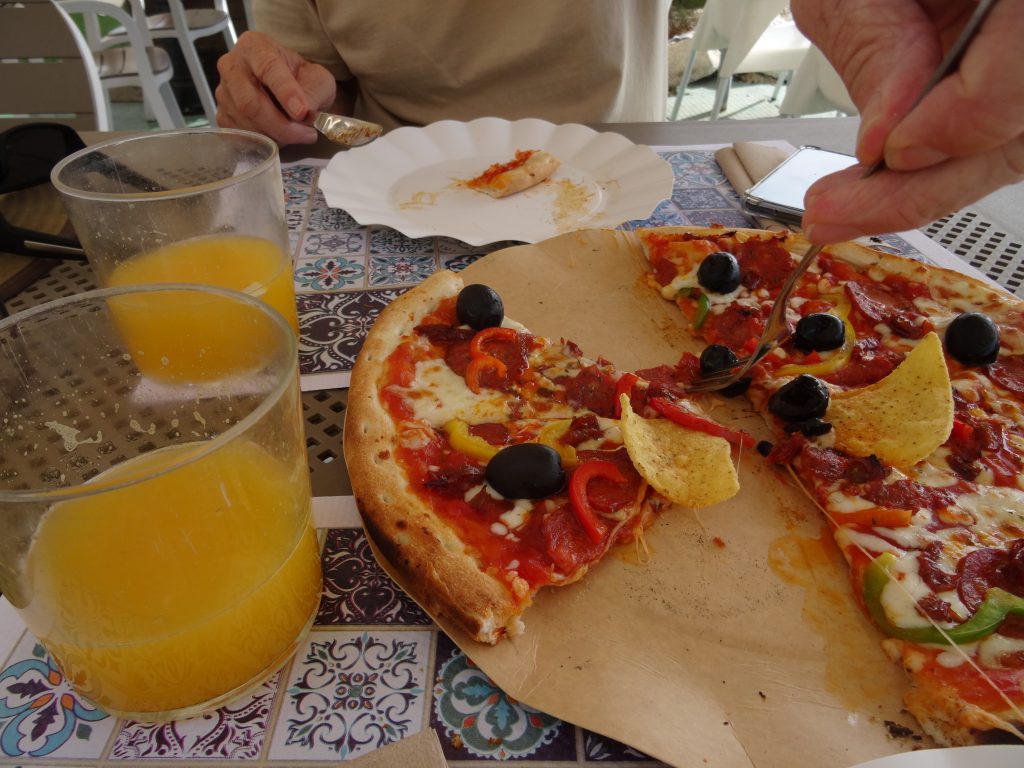
Unexpectedly delicious pizza and juice 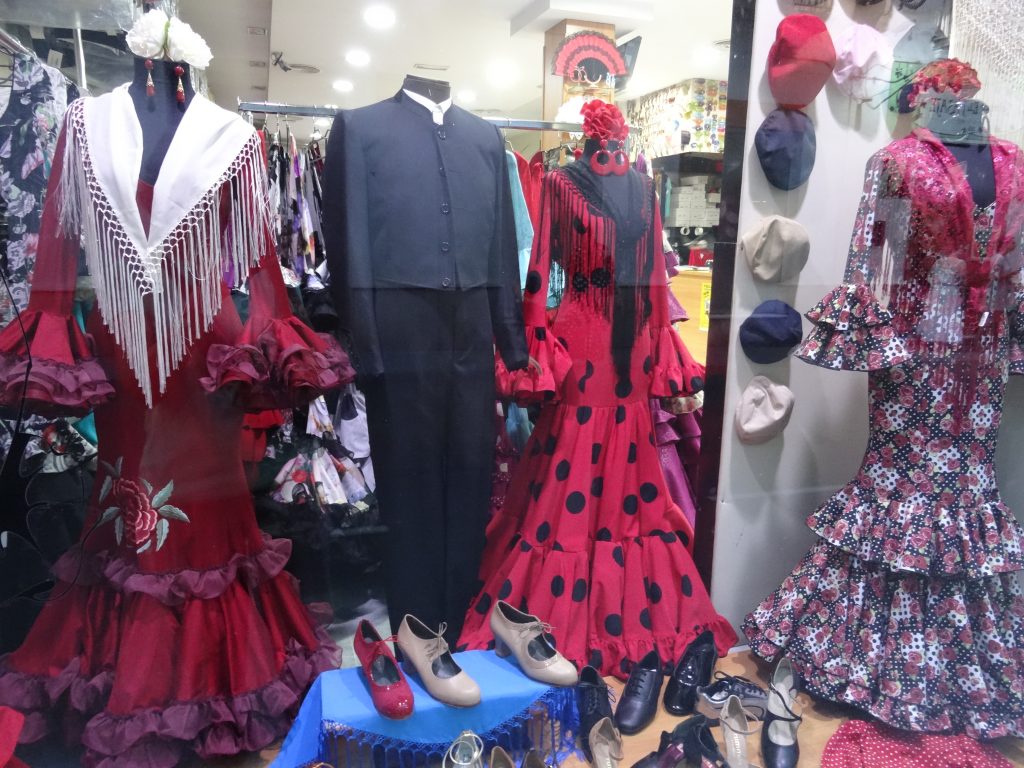
Beautiful Flamenco dresses 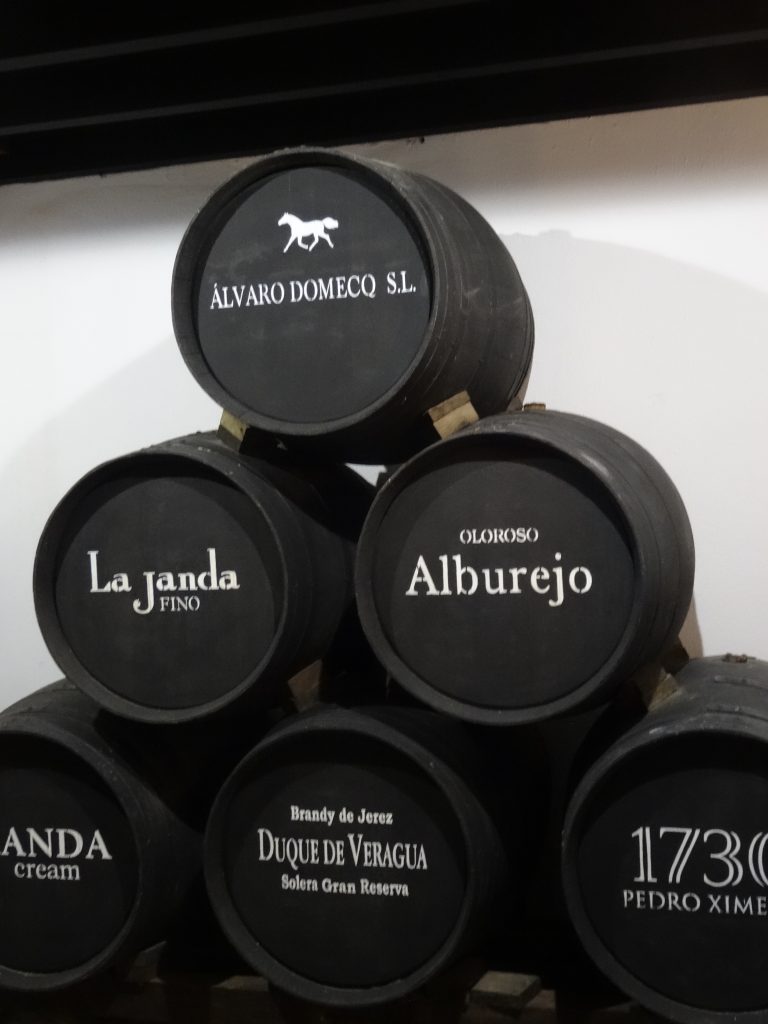
Flamenco Club 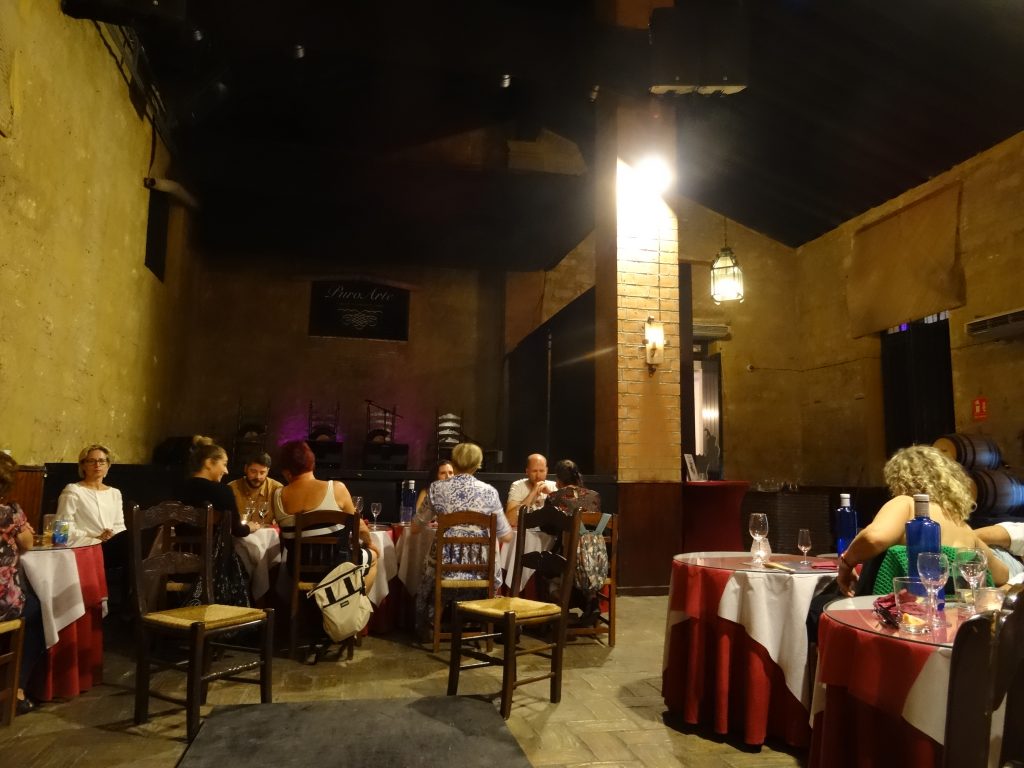
View from our table at Flamenco Tablao 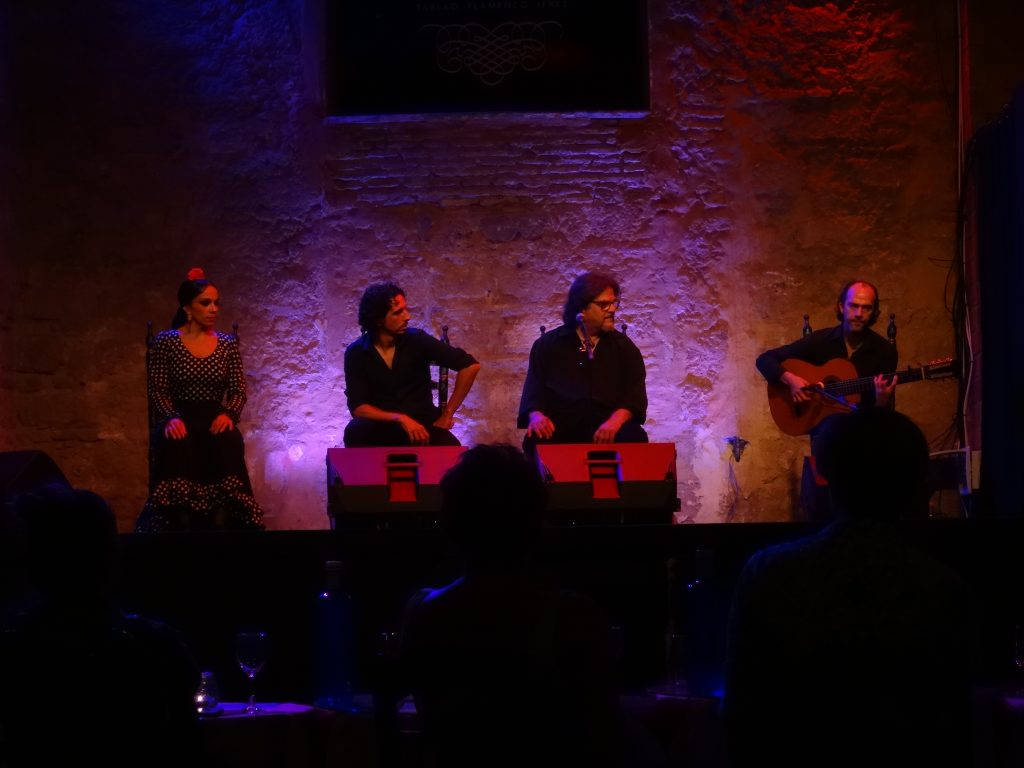
Cantores and guitar 
La Flamenca 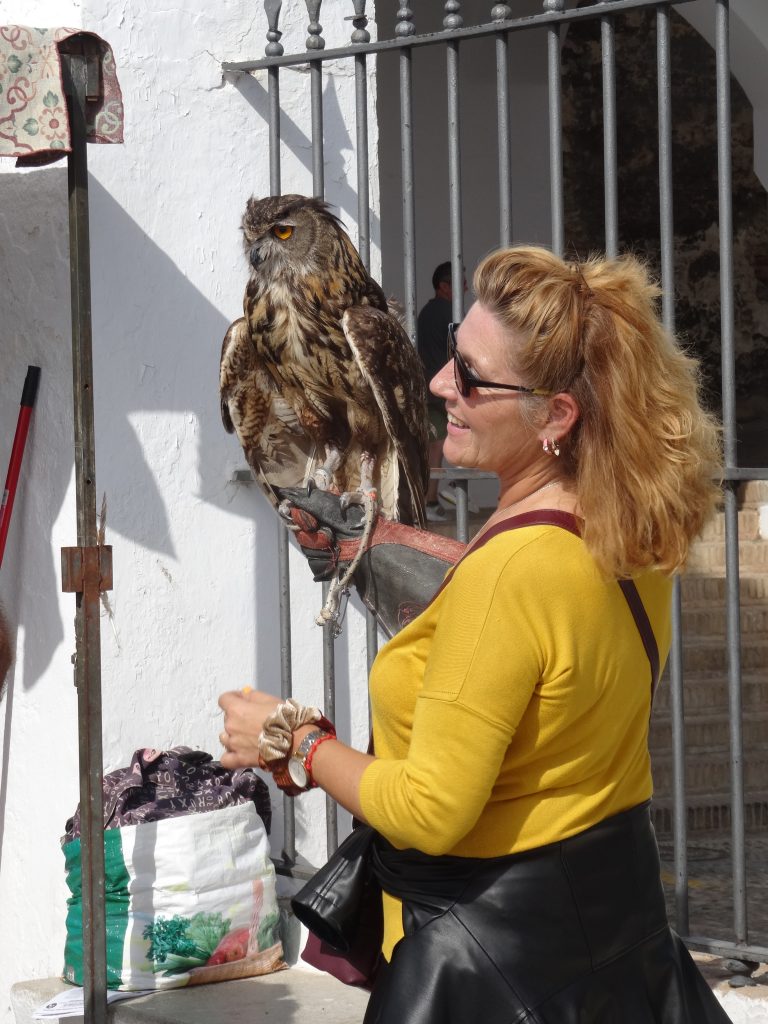
Captive Raptors at Arcos 
Arcos 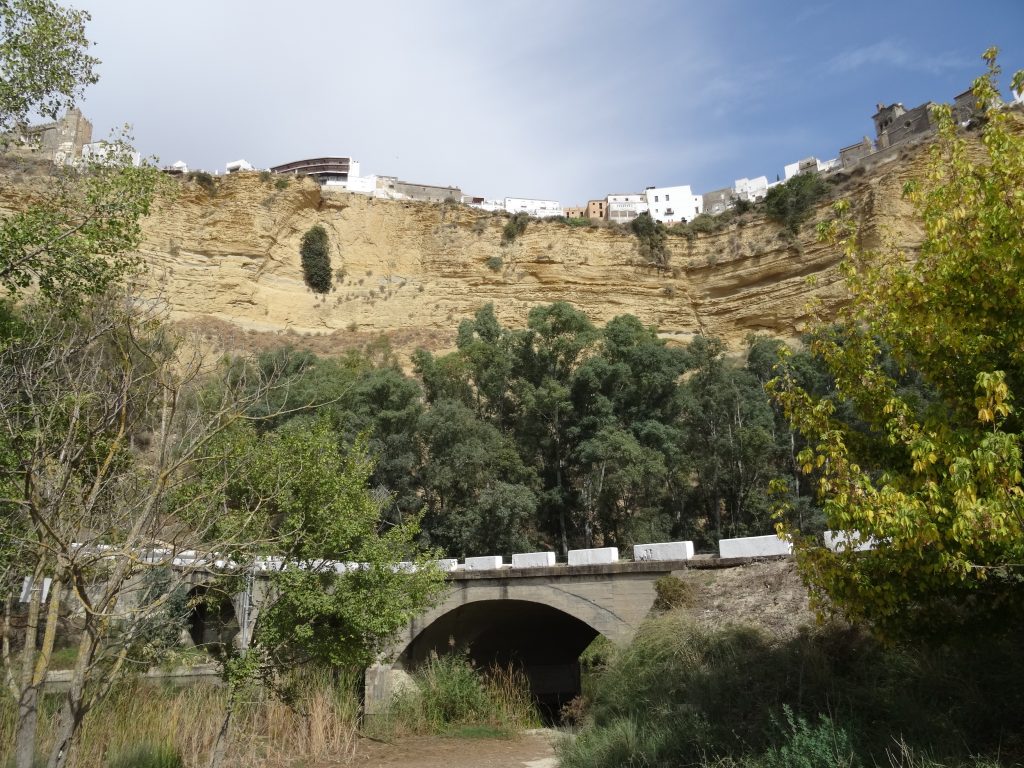
Cliffs at Arcos 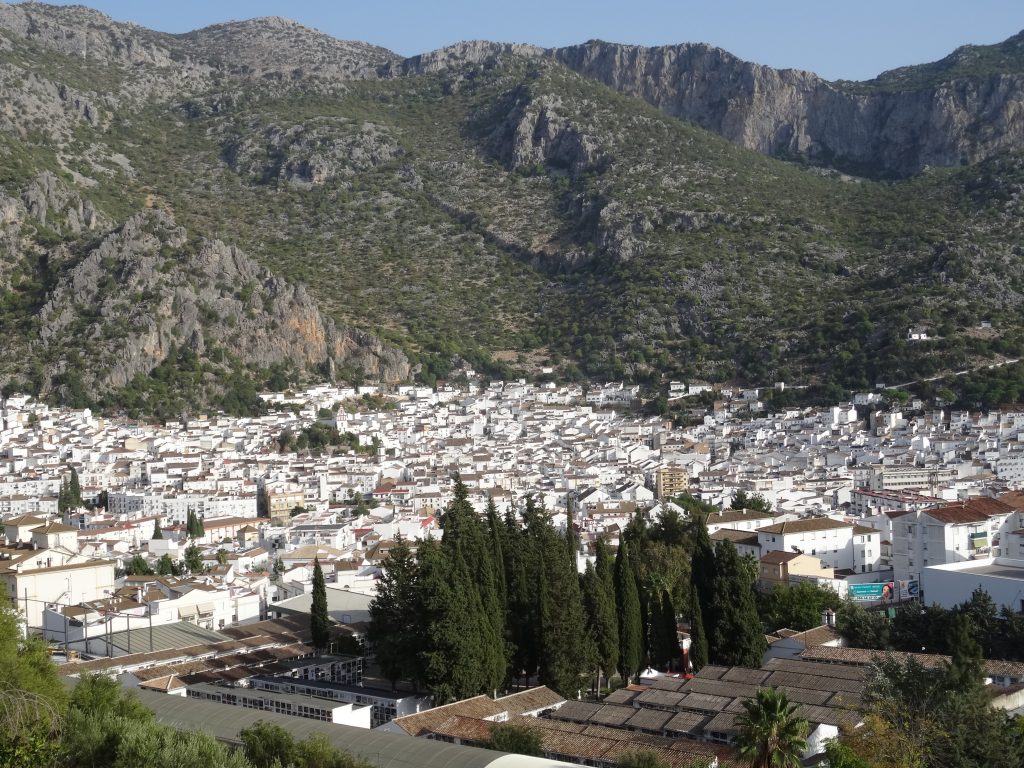
Ubrique 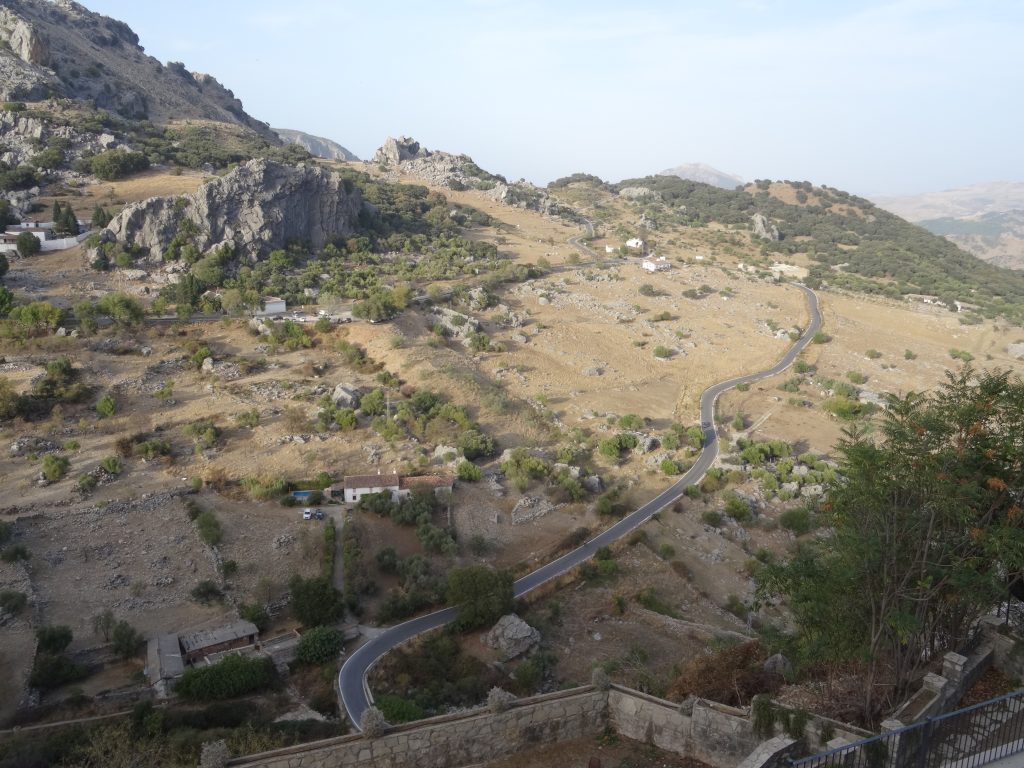
Road to Grazelema 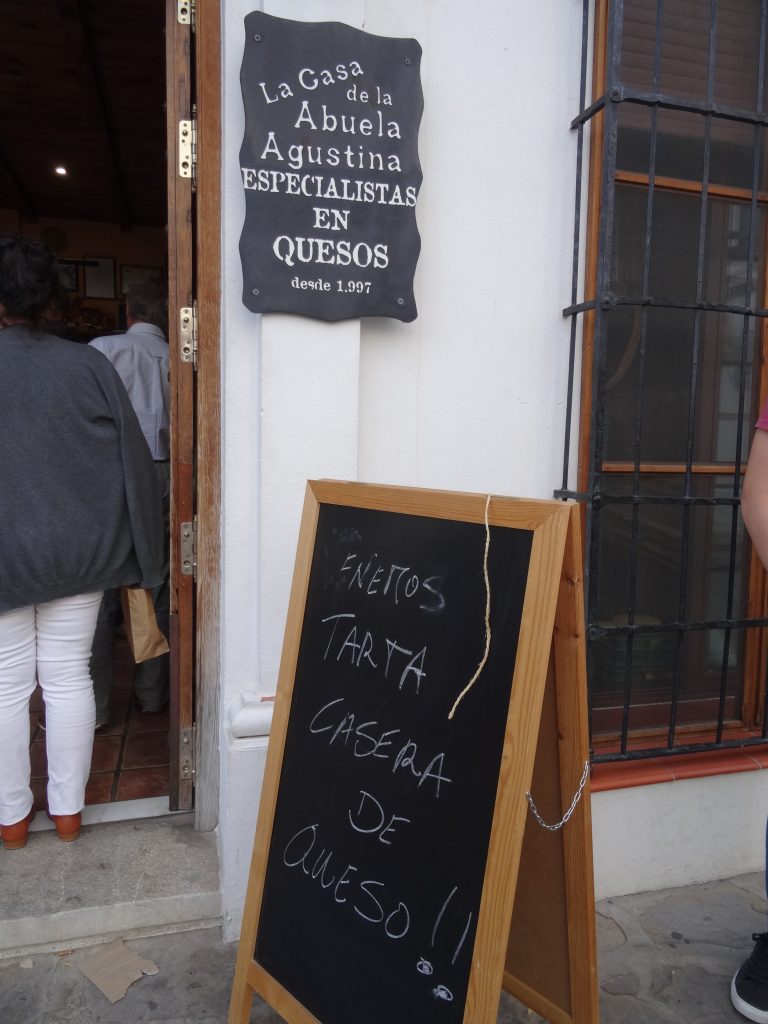
The Cheese shop, Grazelema 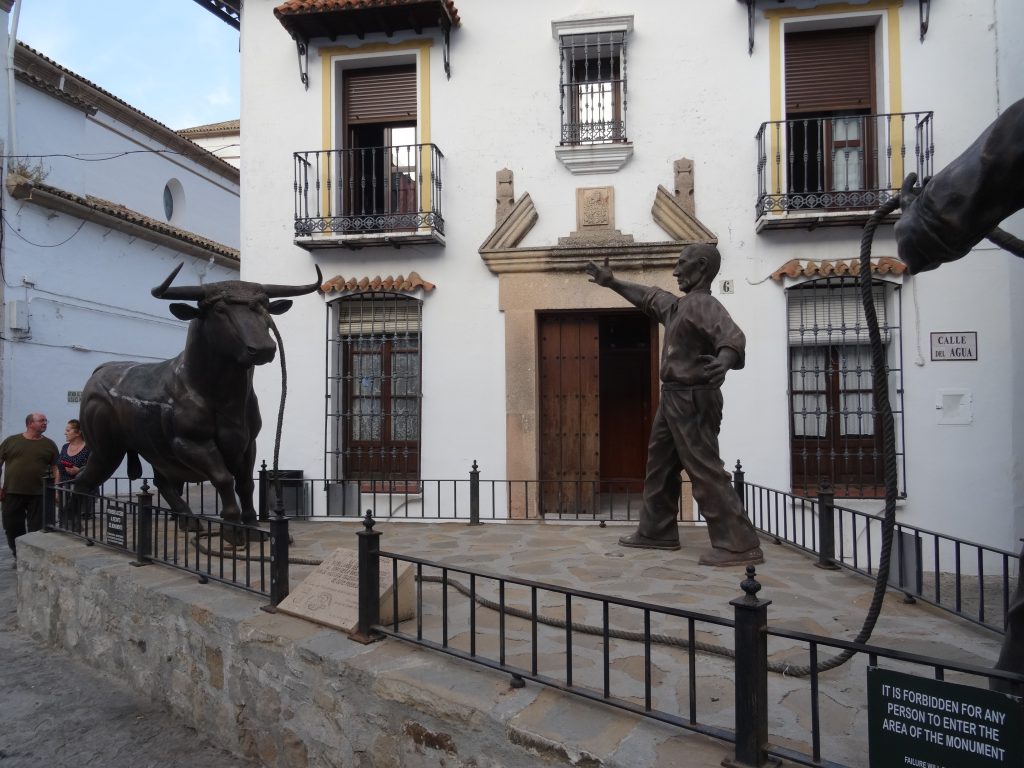
Grazelema -
Nobody expects … The Barber of Seville
Visits to markets are a must! They are the heartbeat of any thriving village, town or city. Vibrant … full of bustle and shouts … colour and smell — it almost grabs and pulls you inside. Fruits and vegetables arranged as carefully as any painted masterpiece — polished, turned, placed for best effect. The prized corner stalls have probably been run by the same family for decades. In Triana, their names and commodities are emblazoned in tile across the wall above. It’s a feast for the senses to just wander … although the temptation to buy something … anything … is overwhelming. Butchers … fishmongers … their counters gleaming
with an assortment of meat and fish we can only dream about in North America … Delicatessens with rows of whole Iberian jamon hanging tantalizingly (it’s a pleasure to watch the skill of slicing) … and a mind-boggling array of cured sausages and meats. This article gives you just a taste: https://viewfromlavila.com/2018/03/17/more-than-just-chorizo-a-guide-to-spanish-cold-meats/
And permeating everything are the heady aromas of roasting coffee, frying food … and freshly baked bread!
Surely, this must be one of the most photographed arches in all of Spain … Nobody expects the Spanish Inquisition! We saw no fewer than three people taking snaps in the space of as many minutes. Then, down a tiny, inauspicious lane, a doorway with spiraling red and blue sign — what I had been hoping for — The Barber of Seville! Glorious!
The Casa de Pilatos __ was worth a visit, although there was an unexpected event in progress when we arrived and it wouldn’t reopen for another hour (we caught a glimpse through the window of a woman in the most wonderful flame-orange flamenco dress , photographers and sound equipment). Wandering down a nearby street we uncovered just the thing to while away the time — a secluded outside alcove with two tables — and tiny coffee shop-cum-tea room attached. They certainly have an eclectic menu – anything from jamon, eggs and tapas, to churros, sandwiches and crepes. Perhaps our choice of lemon and sugar coated crepes and a cup of tea was a little unusual … but it worked. Thin, tangy and positively delicious. Proper loose tea, too.
Opening of the Pilatos was delayed just a bit … but it’s always interesting to watch people as they wait. There are the ones who stand patiently in line, chatting quietly … others seem to ‘expand’ into the space having loud conversations
among themselves or on their phones … then there are the impatient ones — pointedly looking at their watches, tutting loudly, and repeatedly checking with the ticket clerk. Some take the inconvenience as a normal happenstance – wandering off to find a place to sit, or look through their guidebook for their next stop. Always fun to guess nationalities just from observing … sometimes quite incorrectly, I might add.
Leaving the warren of narrow streets which are naturally shaded by the two or three storied buildings, the blast of heat was almost physical … there is a good 8-10 degree difference in temperature. An ice cream wouldn’t come amiss . . . . oh look, there’s an Heladeria on the corner! We chose two sorbets — mandarin and mango — in handmade cones. It was just like eating fruit right off the trees … and it should be mandatory to have cones made this way!
The city at night was fun … first the Cathedral and then on to Plaza de Espana. It was a warm, velvety evening and we had the place almost to ourselves — just a few people like us strolling through. It was even more impressive at night … the lights of the bridges reflected in the inky black water … the echoing clop of an occasional horse carriage.
Heading back over the Puente de Tirana for the last time — what did we see but two National Police cars pulled up haphazardly onto the sidewalk … so they could visit the Churros place across the street. Churros/Donuts – seems there’s no difference.
We have walked, cycled and eaten our way around Sevilla the last 4 days, and loved every minute. It has definitely won our hearts.
Now, on to Jerez.
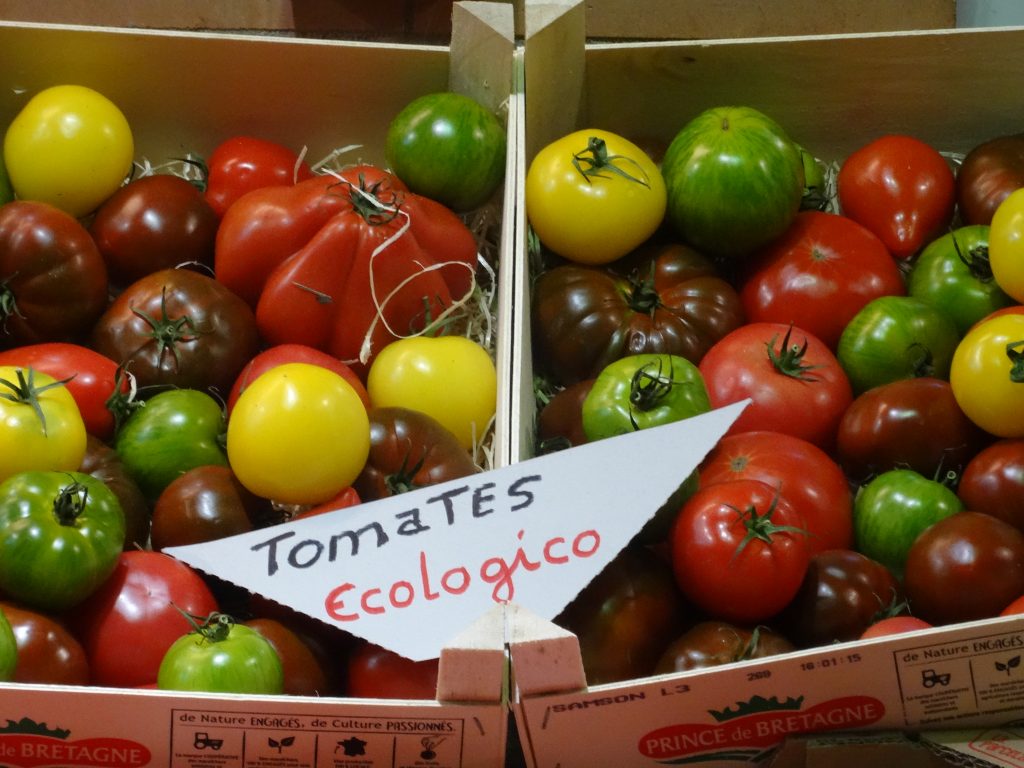
Look at those colours! 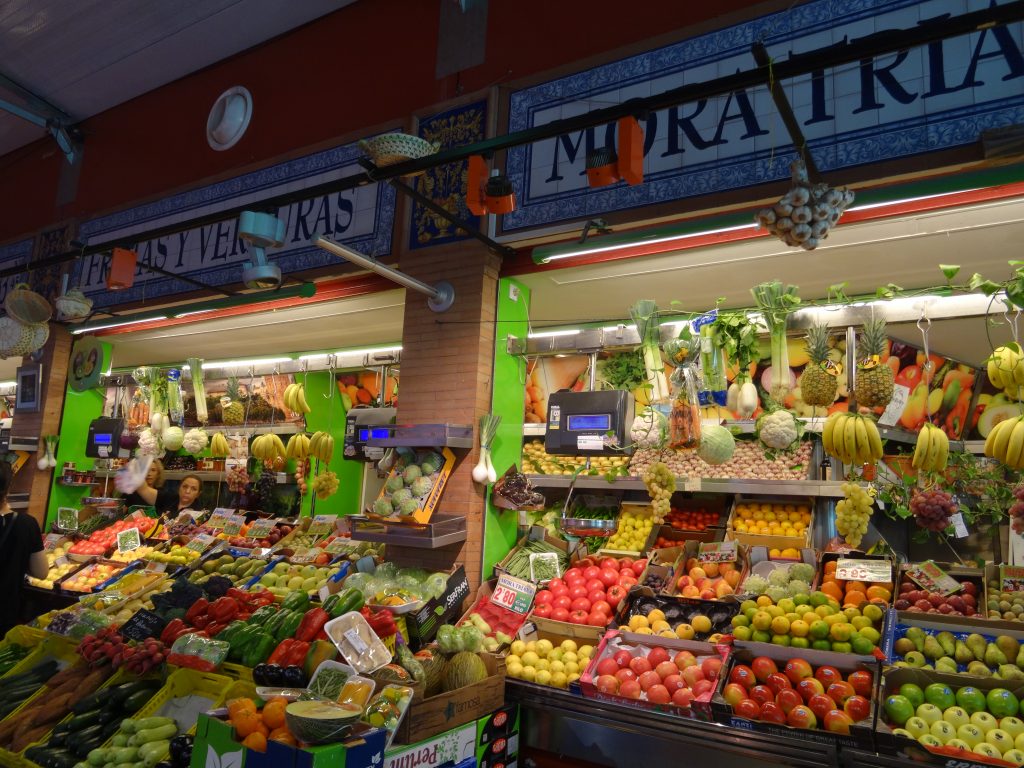
Frutas y Verduras 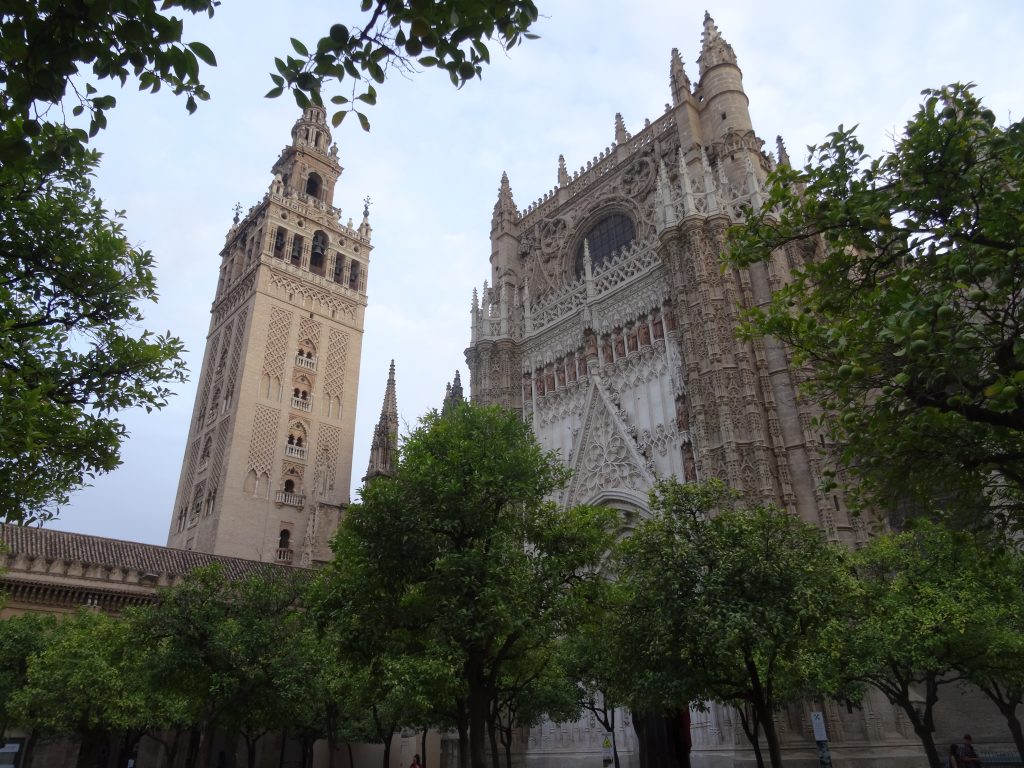
Seville Cathedral 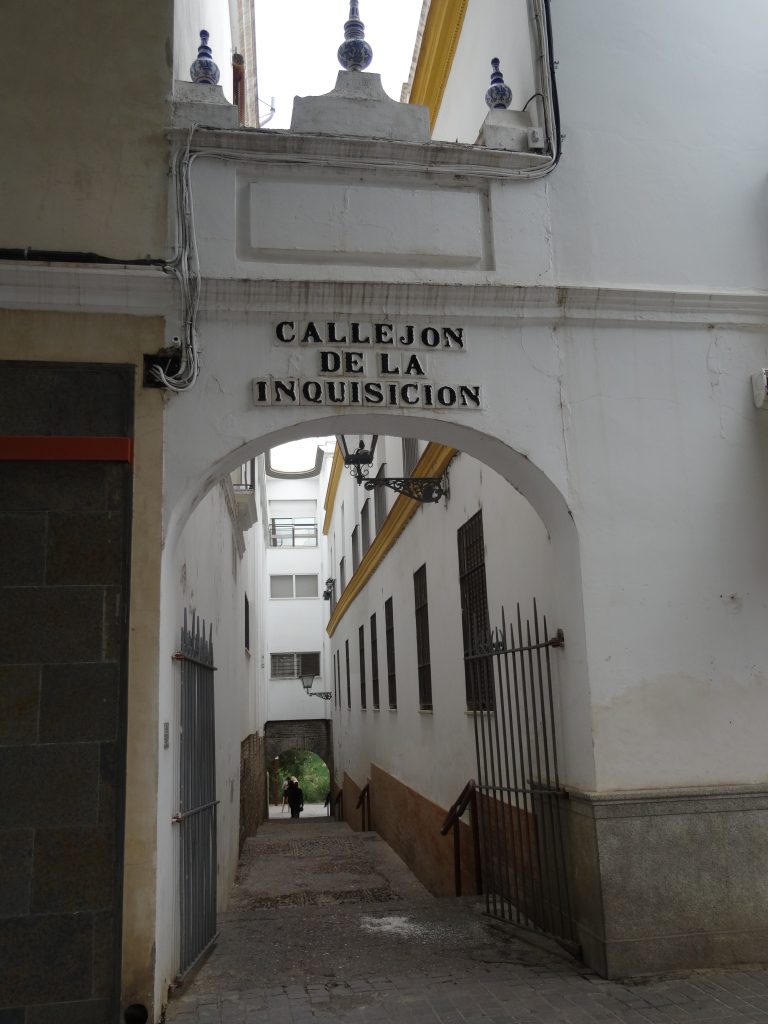
Nobody expects … 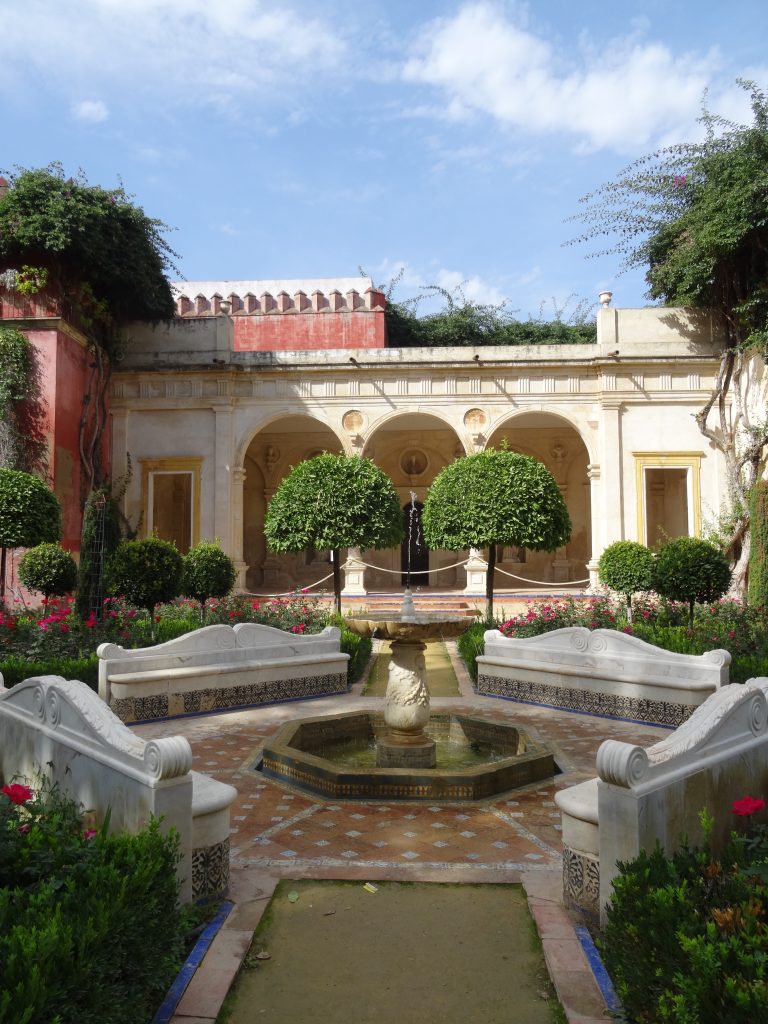
Plaza de Pilatos 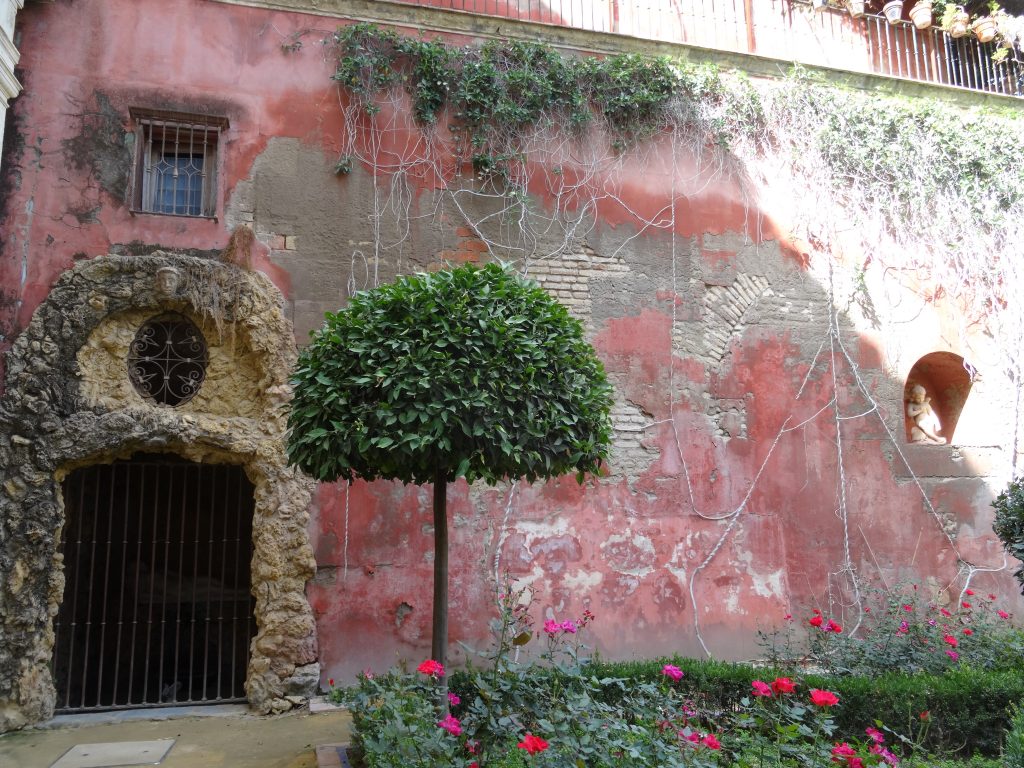
Plaza de Pilatos 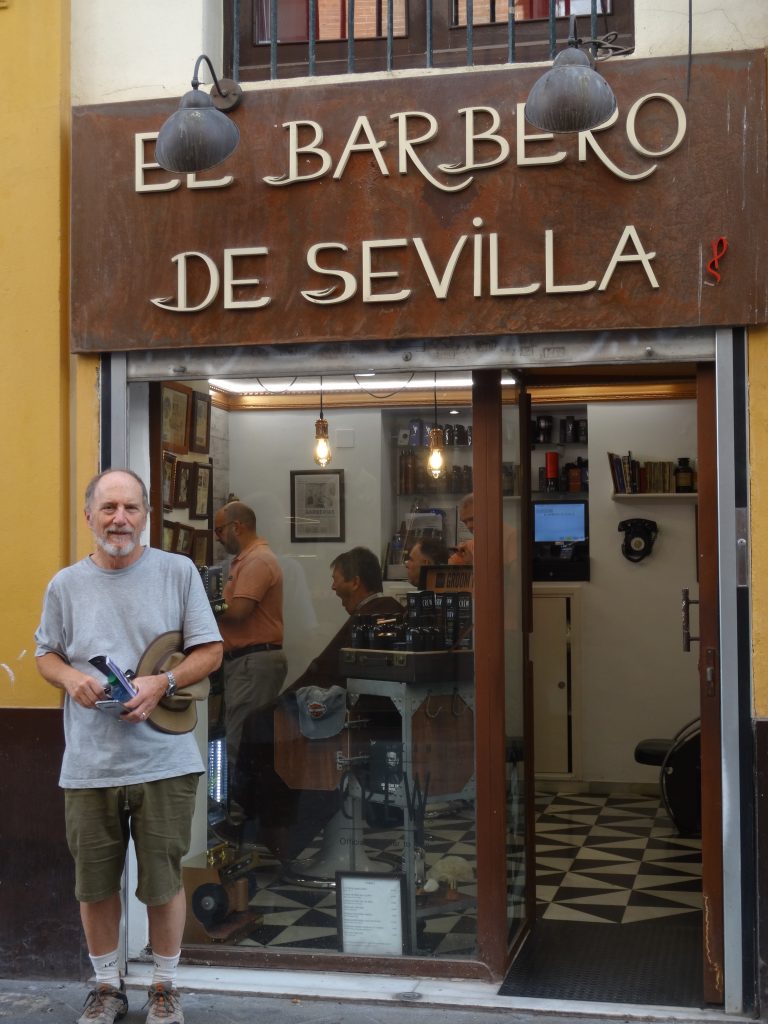
Of course there had to be one! 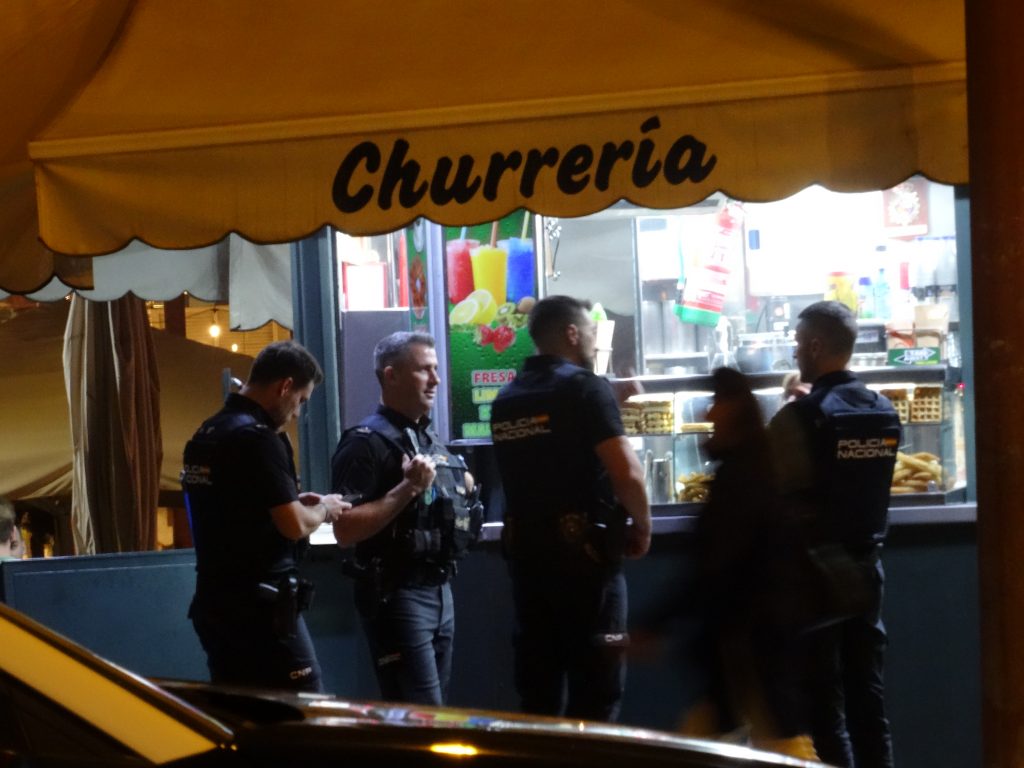
Cops the world over -
Bikes, Flamenco and Baklava
Having been captivated by Antequera … could Seville do the same, I wonder?
What better way to see a city, than by bike … so we rented two from Antonio. Seville has over 150 kms of bike routes throughout and surrounding the the old city centre, and they are well used by visitors and residents alike. For the most the most part lanes are painted green with bi-directional arrows , and often appear on both sides of the roads – separated from cars by a good solid curb. However, on cobblestones for example, the paths are marked with rows of shiny metal disks – not always easy to delineate (for bikers and pedestrians alike). Sometimes, you just have to share with pedestrians as the paths merge. Spanish drivers are courteous … pedestrians are not!
We started off cautiously, and headed for the huge park surrounding the Plaza de Espana https://es.wikipedia.org/wiki/Plaza_de_Espa%C3%B1a_(Sevilla)
Tree-filled, wide sandy avenues, grottos with waterfalls, rows of ducks sunning themselves on the mosaic sides of
water courses (not intended for such purpose!) … and no traffic other than bikes, horse-drawn carriages and people. Rounding a corner we skidded to a halt, as the splendor of the vast, curved edifice unfolded before our eyes. It is truly staggering. The roofs, every balustrade, bridge and the panels depicting all major towns and cities across the country are created in ceramic painted tiles made right here in Triana. Off to the right … having found the perfect acoustic alcove … sat a guitarist. Every classical note clear and sweet. We propped up the bikes
and listened. As we dropped a handful of coins into his case, I asked how long he had been playing guitar — 33 years. First Rock, then Blues and now Classical — he grinned as he gave a quick snippet of each. Such talent.
Riding closer for a look at that magnificent facade … there, under one of the protruding balconies … a flourish of impromptu flamenco. Staccato clapping of hands … a firey stamp, and toss of the head … a swirl of skirt … the swell and throb of the guitar and singer. They had gathered quite a crowd. Two ladies … obviously both flamencas at a younger age … joyfully swooped and spun in front of me. What a delight. As the music and dance ended with a final crescendo, it was discouraging to see how many people quickly melted away with nary a coin being shared … yet they’d been only too pleased to photograph and film the excellent performance. We’d originally rented the bikes for two hours — figuring we’d be tired by that point, but not so. A phone call to Antonio extended our time a further 4+ hours (remember, everything closes between 2:30 and 5:30 … even bike rentals!)
Leaving the safety of the gardens, we sallied forth in search of lunch. Yesterday we’d spotted a Lebanese restaurant right across the road from the University of Seville. The mouth-watering aromas wafting out of the kitchen necessitated further investigation. There was an outdoor table with room to park bikes right alongside. We settled on a Tabbouleh salad and lamb kebab wraps … and were not disappointed! Bursting with freshly-prepared herbs, vegetables and just the right amount of Bulgar wheat, and melt-in-the-mouth skewers of lamb in flatbreads. Oh my! And who could leave without trying even one of their baklava, so we didn’t – we had two. As we sat savouring our food, lineups of people waited patiently for an available table. We’d timed it just right.
Now, to wear off all those glorious calories … off we plunged into the turmoil of the busy streets that circumnavigate the city. Traffic thundered by just a few feet away … separated — but only just. The bike lanes thronged with commuters – both cyclists and electric scooters … overtaking, dodging in and out of the on-coming lane. Definitely kept brakes at the ready! Away from the river it’s less polished and more ‘lived in’ … there are fewer sidewalk cafes and more construction … a touch grubbier perhaps, but it’s more neighbourhood-orientated. Smaller, more intimate churches, bars and restaurants.
Back along the other side of the river … past a rather sad-looking Magic Island complex … presumably some sort of amusement park – complete with a defunct rocket from the European Space Agency – but with an air of neglect. Did it close up for the winter, or was it something more permanent?
By 4:30 it had become very muggy … we couldn’t return the bikes yet, so we found a shaded bench along the river bank and sat sipping our water while watching the river-life. One private yacht-for-rent could be heard long before it put in an appearance. With a captive audience of a dozen or so on the upper deck, two flamenco singer/guitarists – amplified to the maximum — wailed and warbled enthusiastically . What they lacked in talent, they made up for in volume. Forcing their audience (and people on the shore) to endure, with no hope of escape, as the boat drifted first upstream, then back down!
With bikes safely returned, we only had 20 minutes until our ticket time at the cathedral (we hadn’t planned on an all day bike tour when booking!). Weaving through the crowded streets with pedestrians heading determinedly towards drinks and food, we arrived with 5 minutes to spare . . . . but to the wrong entrance. The one we wanted was completely on the other side . . . and this building takes up an entire city block!
Tackling the tower first (it closes at 7:00) there were no steps this time, but a series of 37 upward slopes and right-angle turns … puff, puff. Great 360 views, and the tower still possesses it’s carillon of bells in all sizes. Surely they aren’t still used while people are up here? Just in case, we made sure to descend before the 7:00 pm cutoff. And just as well, too. Precisely on the hour a great clamour arose overhead as the smaller bells on all four sides rang out … as though the Gates of Hades had just opened. Talk about closing time! I bet anyone still up there would have been deaf for a week.
The interior of the cathedral was impressive in regards size and architecture, but it didn’t have the feeling and soul of Barcelona’s Sagrada. One very pleasant bonus to having a late tour, is the quiet and lack of other visitors. Time to sit and contemplate.
Wearily we trudged back across the bridge into Triana. It had been a long day … but lunch had been quite a while ago. Antonio, a native son of Triana, had highly recommended a bar which did the absolute BEST tapas. It was ten to eight when we arrived and the sign in the window quite clearly stated Cerrado … even though all the tables outside (but one) were occupied. As we stood undecided, an older senor pointed at the table and asked if we were taking it, his intentions of commandeering it were clear. In through the window we could see food being arranged on the counters in preparation of opening …. “no, no, no … esta ocupada!” … and we sat our bottoms down and waited with anticipation.
Fearing a repeat of the other night, we ordered with confidence — not wishing to appear dithery tourists. Beer first . . . then some tapas. Maybe something with vegetables – that salad mix might be good … and you can’t go wrong with lamb skewers. Er … in hindsight, what I thought was a salad consisting of radishes, beets, and zucchini was in actual fact an ‘either or’ selection. The radishes were very fresh, mind .. and perfectly seasoned with olive oil and salt … and they certainly cleared the palate (and the sinuses) <grin> Oh well, you can’t win ’em all! But the lamb! Goodness, what flavour – and cooked to perfection. I asked if they had flans, (we’ve been unable find find any yet!) but sadly no . . . so we ordered more tapas instead. Chipirones (baby squid) in green sauce (herbs). I don’t think either of us have had squid that tender before. What a day . . . bicycles, guitars, flamenco and outstanding food.
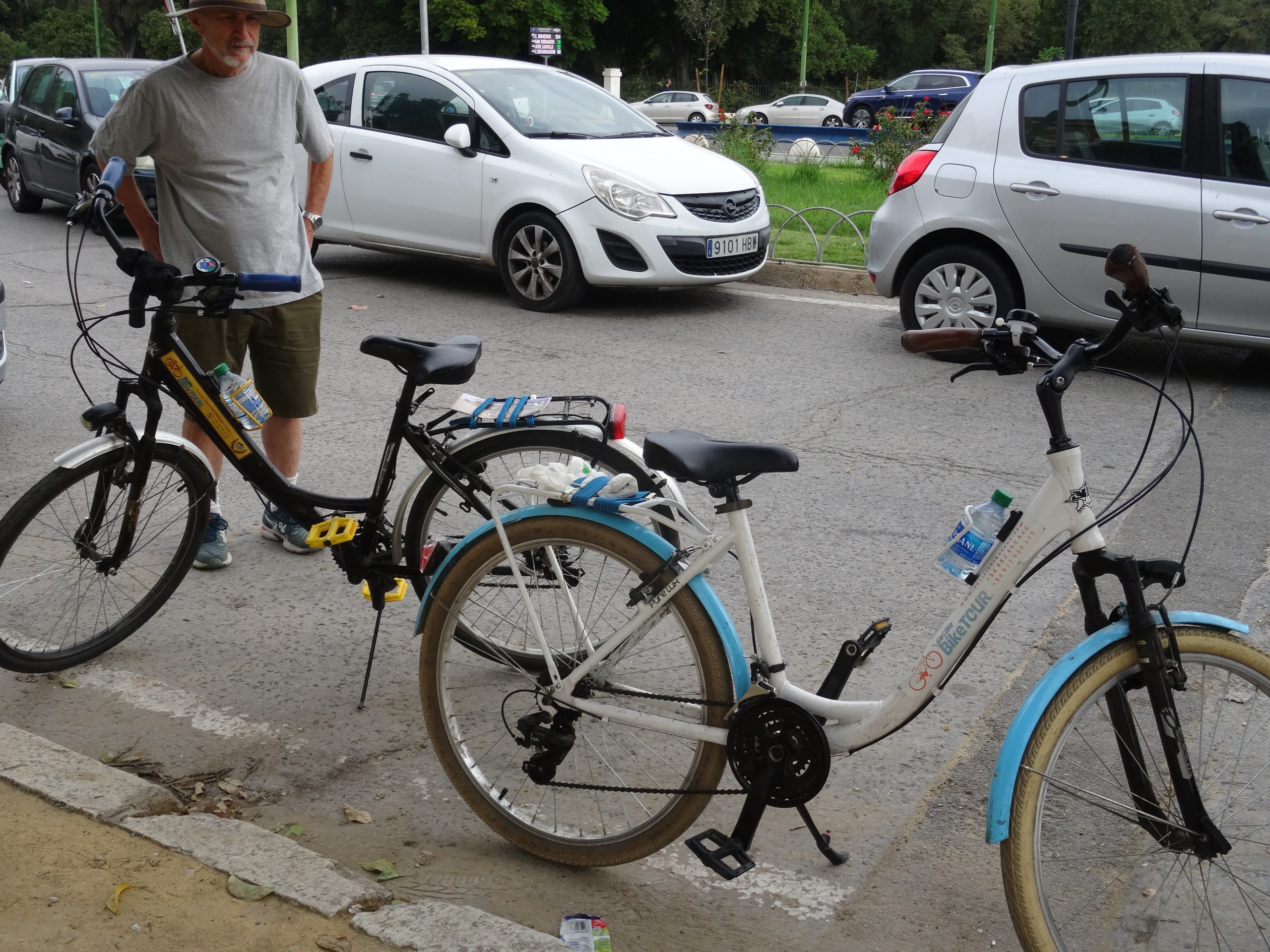
Bikes from Antonio 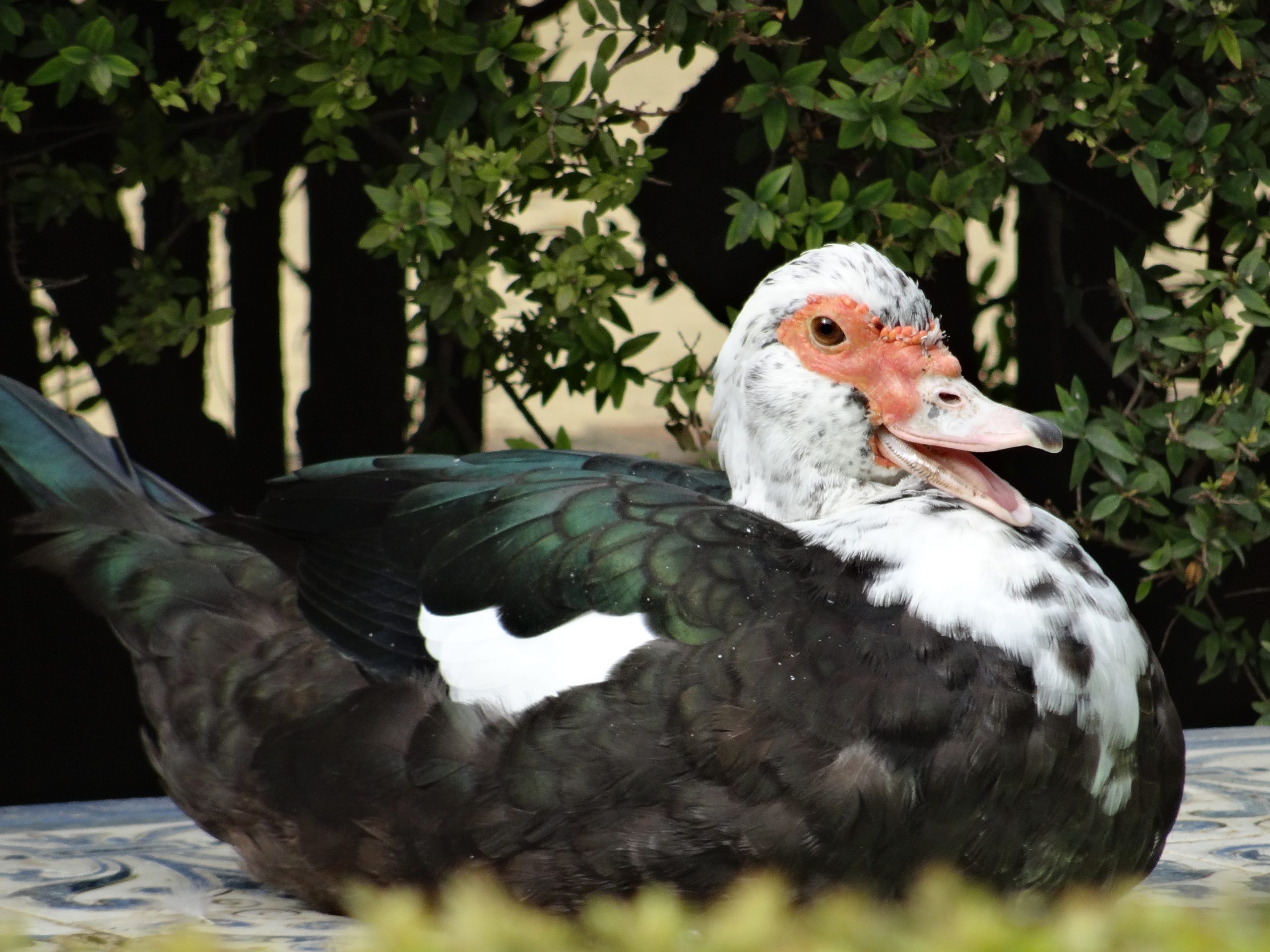
Happy Muscovy Duck 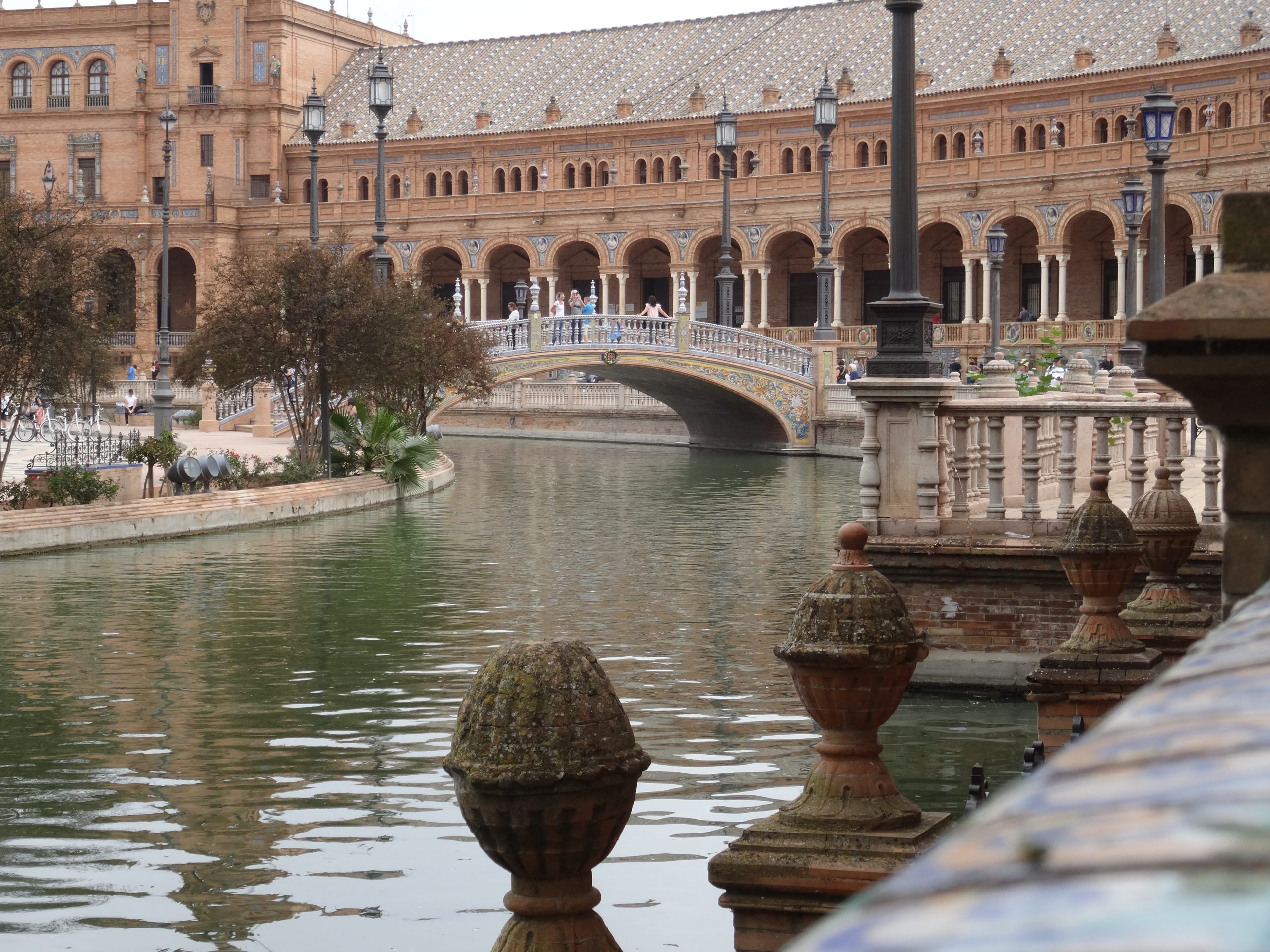
Plaza de Espana 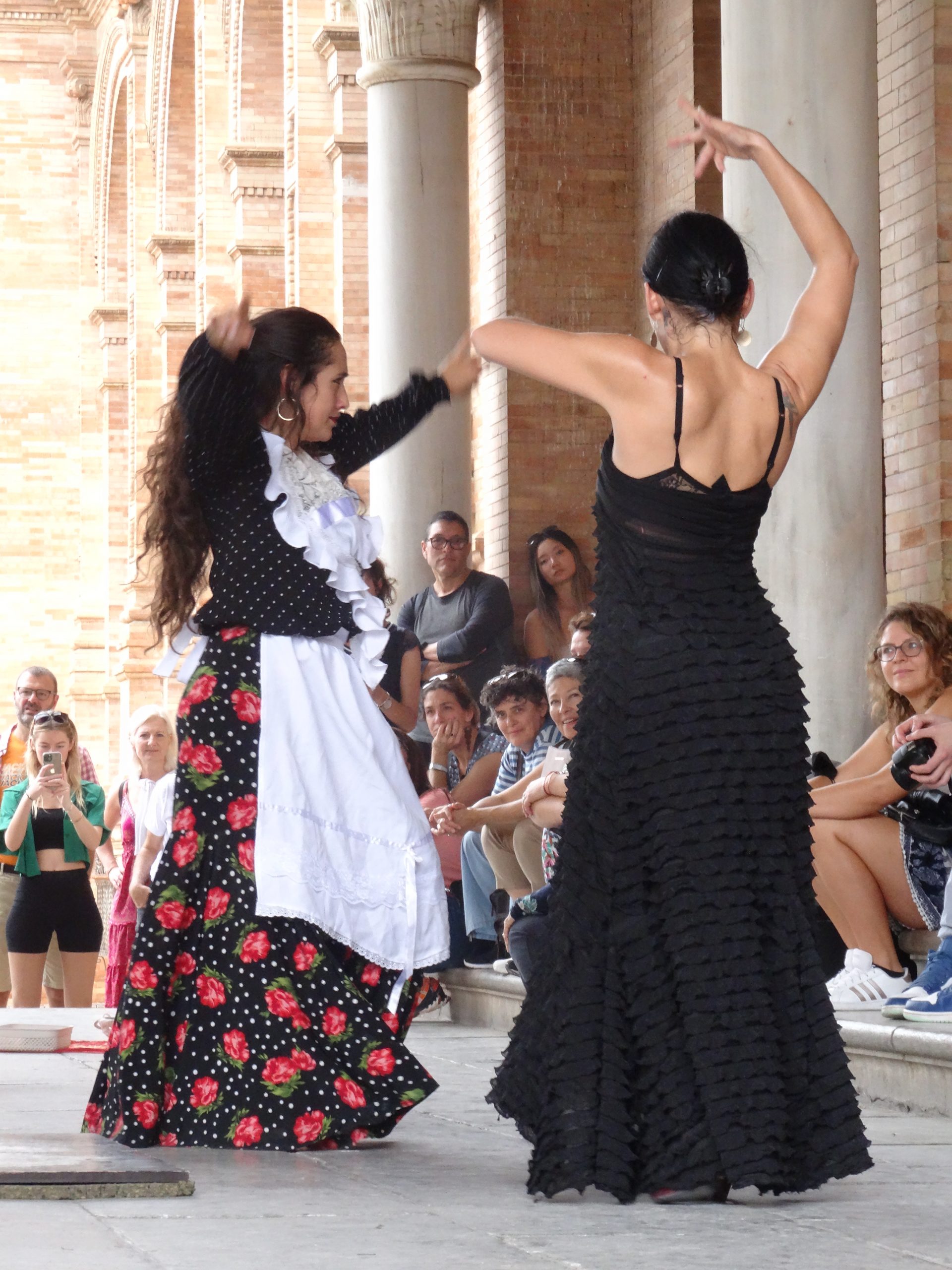
Las Flamencas 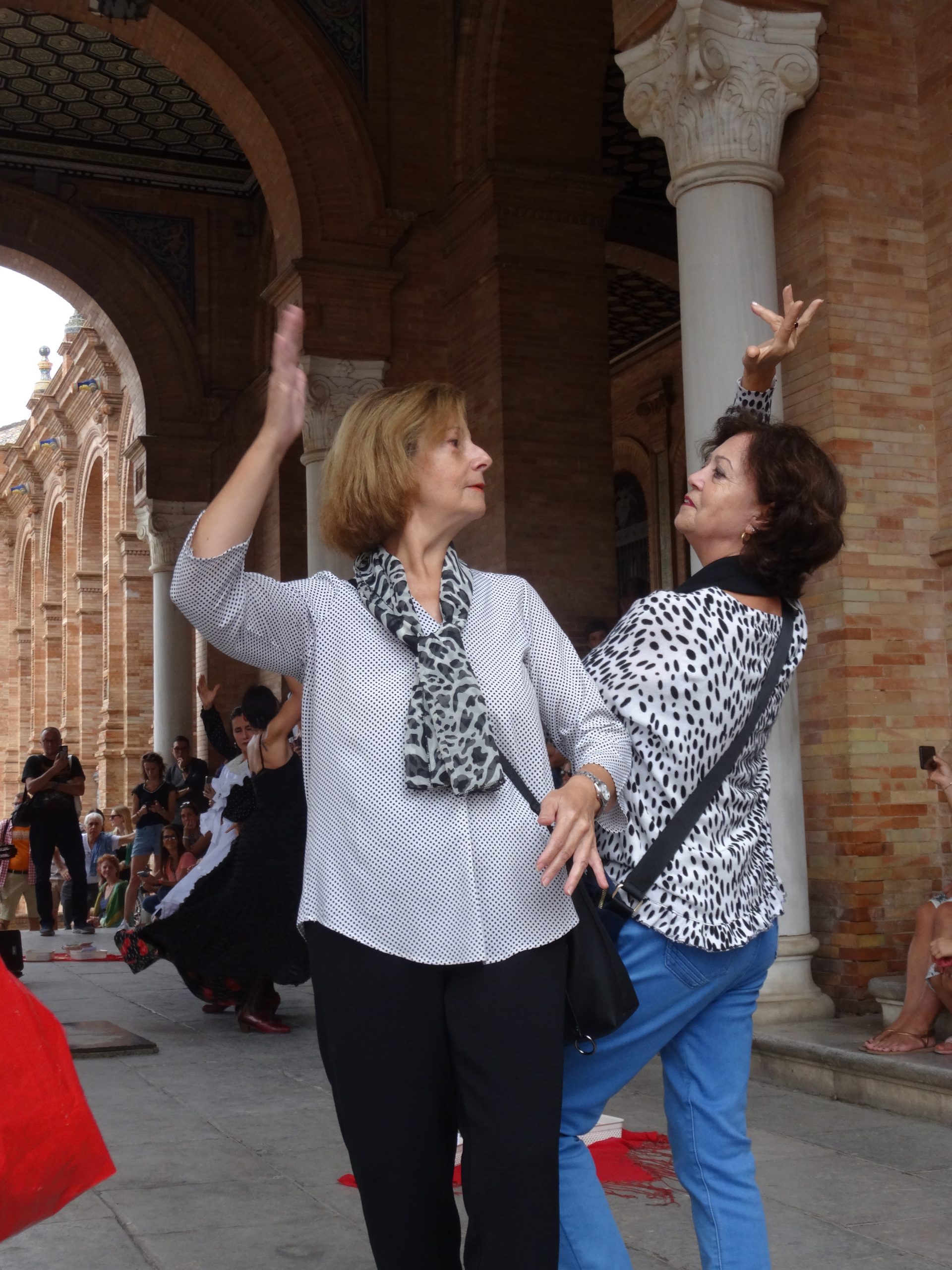
The Other Flamencas 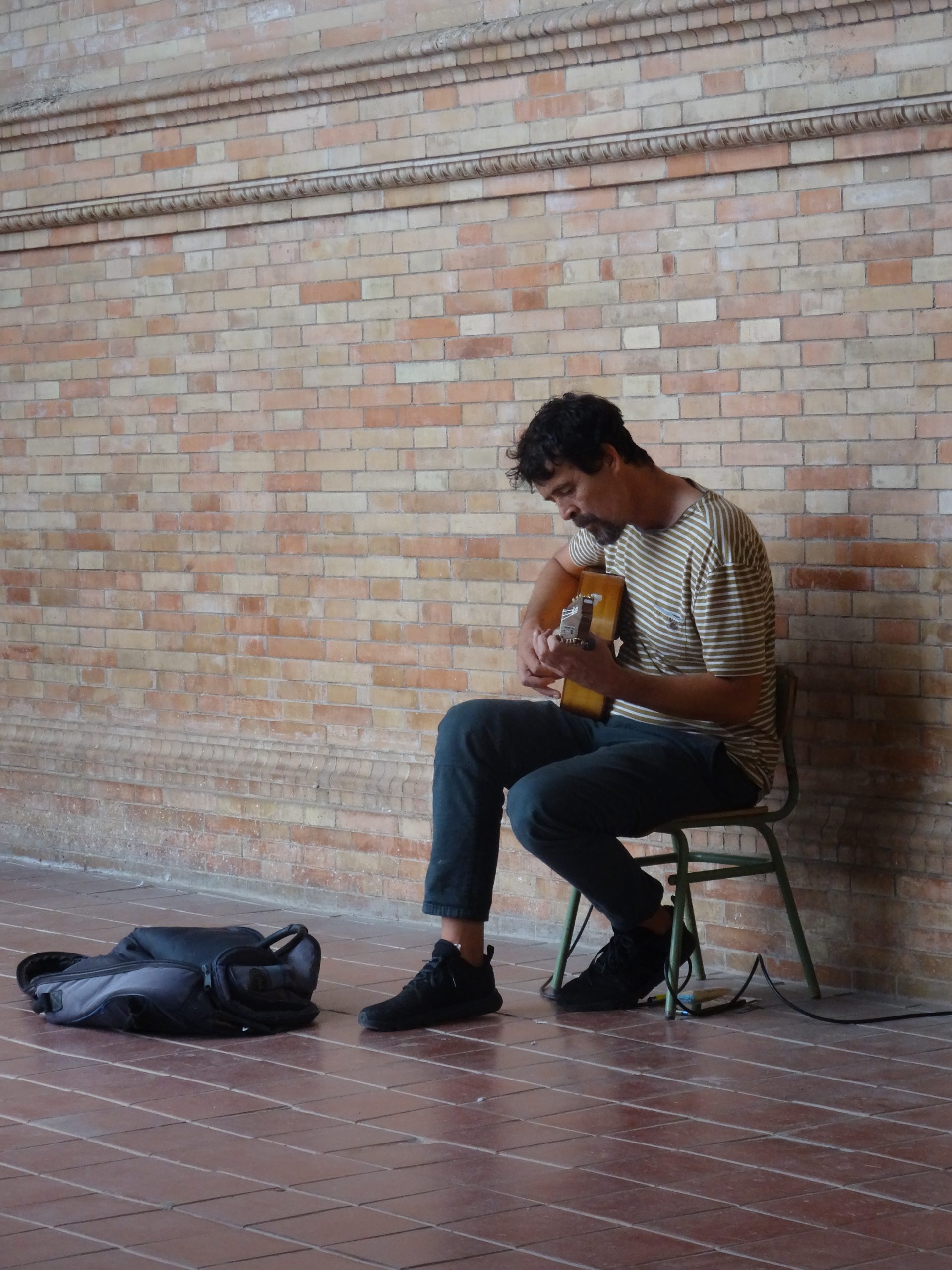
Guitarist at Plaza de Espana 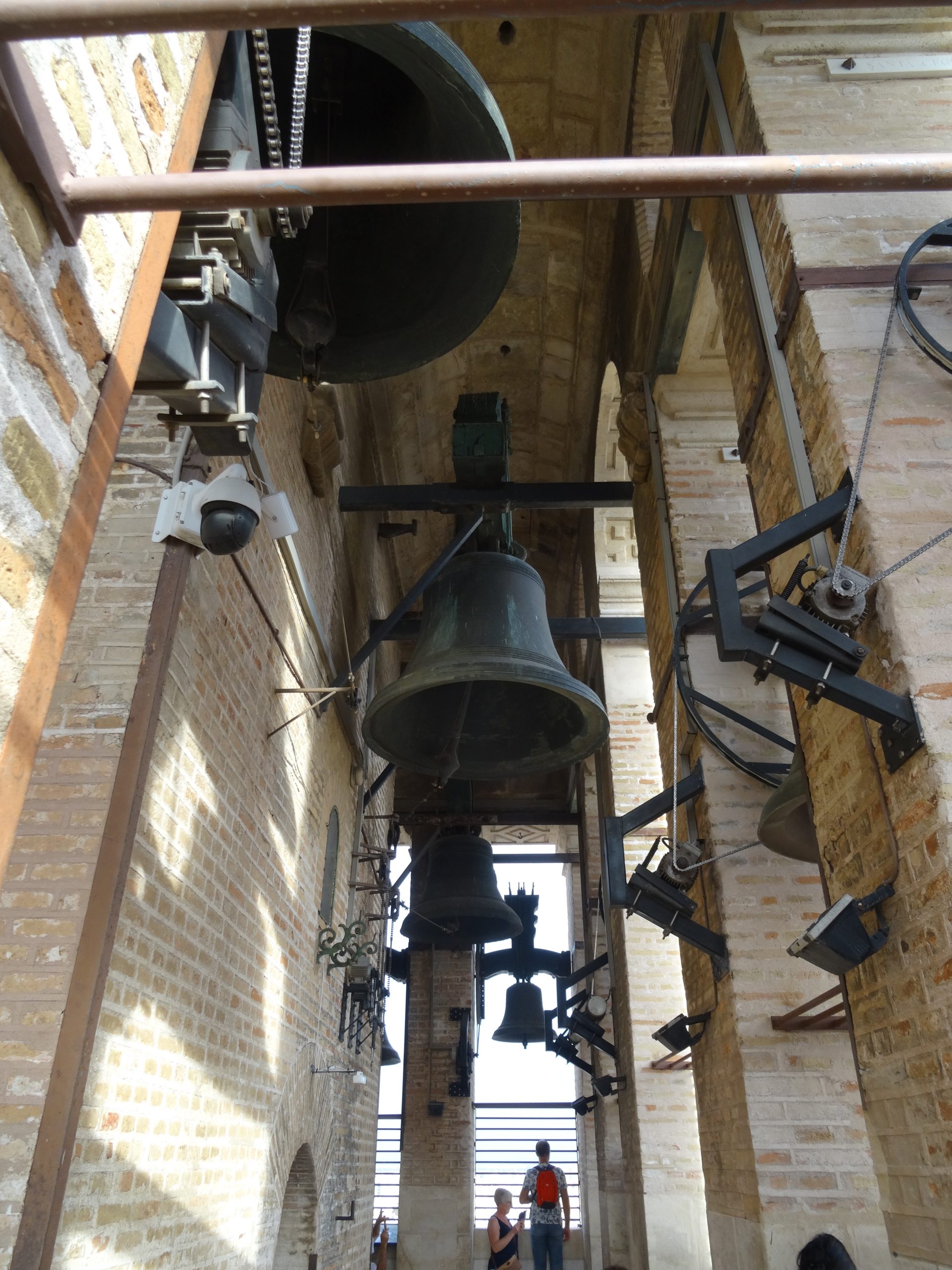
Just some of the Bells! 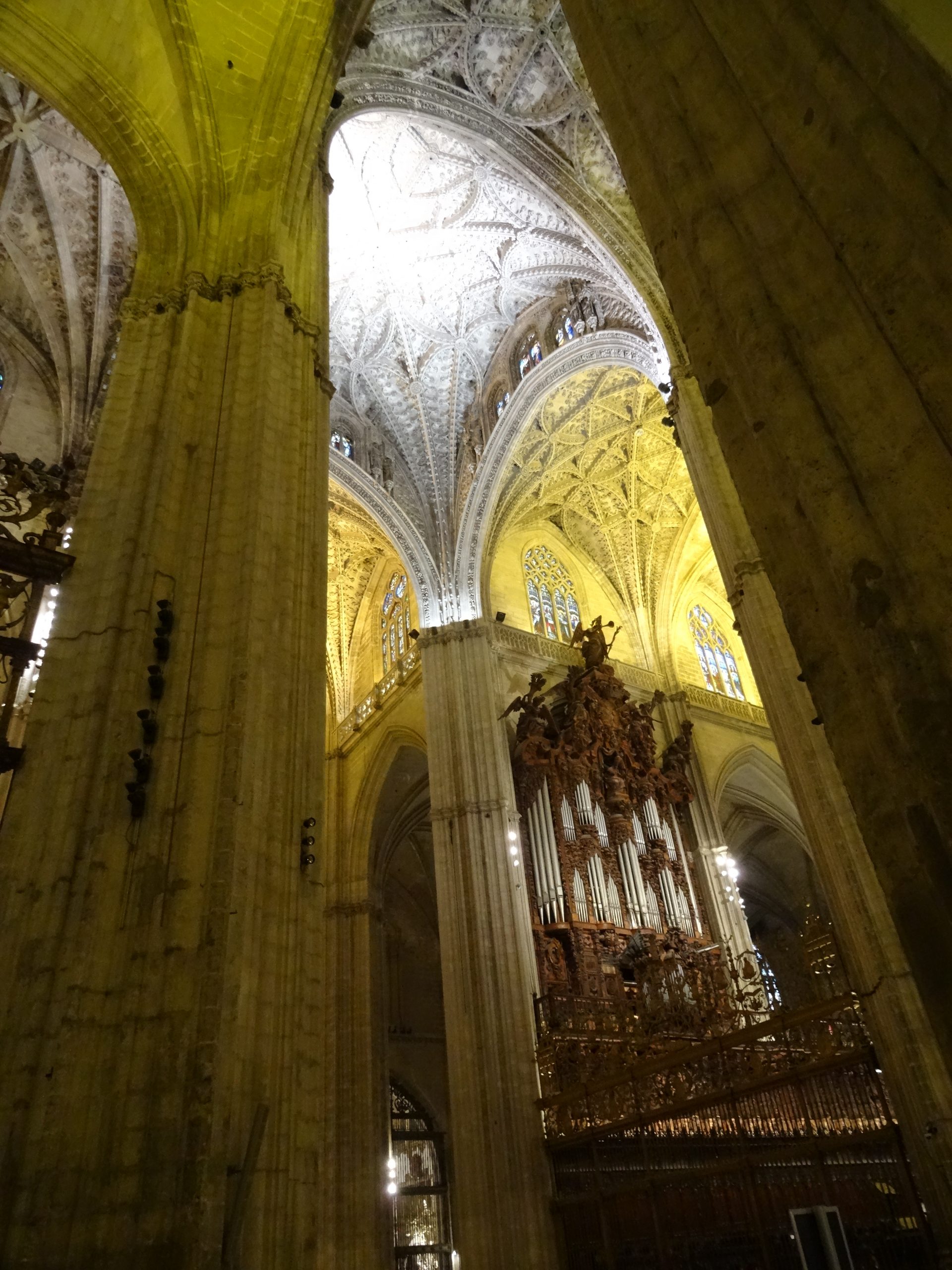
Seville’s Cathedral Arches -
Welcome to Sevilla
Just a short hour’s drive, and we were in Seville. We are staying in the Barrio de Triana – a neighbourhood just across the Guadalquivir River … considered by local Trianeros to be equally as important as the main city itself – if not more so! https://en.wikipedia.org/wiki/Triana,_Seville
Less touristy and famous for its potteries and the fabulously colourful tilework which can be seen on every building,
street sign church and bar. This is where locals live, work, eat, shop . . . and sit over beer and tapas with friends in the evening.
How lucky is that! … we found an honest-to-goodness legal street parking spot, and only a couple of blocks away. We retrieved the apartment keys from the bar on the corner,and trundled our ever-increasing possessions along noisy cobble stones (carefully avoiding the doggie deposits). With only four days to explore, we were determined not to waste a minute of them, so the bags were dumped, and we headed out.
The afternoon was perfect. A quick perusal of the market, but it was late in the day and most of the stalls were tightly shuttered — only the restaurant booths were still in full swing. The Puente de Triana (bridge) was right next door, spanning the green river which was a-buzz with virtually anything that could float and be propelled by human power… kayaks, canoes, rowing skulls, paddleboards — although I wonder about the wisdom of a ‘group paddleboard’!
Rowers from
Norway and Poland (I think) – judging from the flags on their oars – were training as coaches from the support boats broadcast instructions/encouragement via megaphones. People walked, sat and fished along the riverbank … and even collected after dark to picnic or chat, and watch the lights of the city.
We have tickets for the Alcazar tomorrow, but thought it prudent to scout out the route beforehand. In the Jardines de Murillo brilliant green Monk Parrots clustered in the palm trees – screeching noisily as they swooped from one tree to next. They make a huge racket when flocks of them roost for the night. The neighbouring apartment dwellers are less than enamoured. https://mappingspain.com/the-exotic-green-parrots-of-spain/
Aha … there, in the middle of the gardens, is the column commemorating Christopher Columbus (Cristóbal Colón)
with his ship The Santa Maria (La Gallega), his sponsors Ferdinand and Isabella, and the date 1492. This I remember from decades ago … a searingly hot day, where the pavement burned your feet right through sandals! Not quite so hot today – very pleasant if a little overcast.
For dinner we tried a nearby place recommended by the apartment host. We arrived suitably late, even by Spanish standards, but there were few people about. Perhaps because it was Monday? The bar – an homage to bullfighting – boasted a faded matador’s suit in a glass cabinet, various accouterments of the fight … and two massive mounted bulls’ heads on the wall … horns wickedly sharp … glass eyes glaring down accusingly. They were in a cordoned off area making photos difficult. A disinterested waiter brought beer, and then seemed to lose all interest as we deliberated on which tapas to try. We ordered more beers … these were banged down, dismissively. Stories of surly waiters abound, but this was our first encounter – perhaps he didn’t care for non-Spanish-speaking patrons. The food was … okay. The croquettas were not a patch on the ones in Barcelona … the mushroom and asparagus omelet was decidedly better,the sardinas con tomate mermelada however, were nicely smoked and very tasty. Too bad the camareros were jerks. Can’t win them all, I ‘spose.
On the other hand, the Alcazar was magnificent, and absolutely not to be missed! Busy, but not congested … phenomenal mosaics, intricately carved archways, ceilings and doors, immense tapestries, tiled water courses and vast tranquil gardens. You’d think we’d be a little complacent by now . . . but not here. This video gives you just a taste: https://youtu.be/XAp22X6-jtc
A reviving refreshment break of hot chocolate and a chicken empanada under the bougainvillea and wisteria arbor … with peacocks pecking around the tables instead of pigeons … children (and adults) were enthralled. We finally left after 4 hours … not because we’d seen everything, but because our feet needed a break.
Directly opposite, across the plaza is the magnificence that is Seville’s Cathedral with an almost never-ending line of horse-drawn carriages transporting visitors around the plaza and cathedral. The clip-clop of horse-shoes echoing off the walls.
On one of the main streets, a puppeteer with an entire orchestra – cleverly coordinated to the music — with a solo violinist taking centre stage
Further along the river bank a life-size replica of Ferdinand Magellan’s sailing ship – the Victoria – sat at anchor — this current vessel is a collaboration between Spain and Portugal to commemorate 500 years of his voyage around the world.
With a small supermercado and fruteria just a few doors down, we grabbed the makings of dinner for tonight … plump chicken thighs, red, yellow and green peppers, mushrooms, onions and tomatoes simmered with basil, oregano and a dash of piri piri chili powder. Not bad … with bread to soak up the sauce.
Ceramic Dome Group Paddleboard! Christopher Columbus Column Alcazar Seville Gates to garden, Alcazar Horse Carriage, one of dozens Puppet orchestra Replica of Magellan’s ship “Victoria” -
Carmona & A Courtyard of Oranges
Leaving the hazy skies around Antequera behind, you could see the cause … several processing plants in the distance emitting plumes of white smoke or steam which hung in the still air … an almost intangible hint of olive too.
I thought we’d seen olive groves, but driving the road towards Sevilla, nothing prepares you for production on this magnitude. Intense. Dense. Massive … often single operations as far as the eye can see, and the landscape is much flatter here. Sadly, none appear to be actively harvesting at the moment – that would have been a sight.
Carmona rises from the flat surrounding plain, rather like the bluffs of Ronda. The fields, now ploughed and empty, would have been a sea of yellow sunflowers in the summer. Guarding the gates is the fort and Puerta de Sevilla (Door of Seville) on the right … spectacular domed churches with their gleaming tiles on the left. Immediately one is plunged into a maze of one-way streets lined with parked cars, restaurants spilling their tables over the sidewalks, and people, in ones and twos, or entire groups Parking – as always – is an issue. Bright blue ‘P’ signs confidently direct you off … only to vanish into thin air. Streets all seem to have no parking symbols, which obviously no-one pays attention to. We took a chance and squeezed in. I think tow trucks would be hard pressed to maneuver here! (she said hopefully). Figuring it was easier to carry our lunch inside, we found a convenient bench and sat munching. People wandered by with a nod, smile or buenas … we even got wished buon provecho (bon apetit!). One salivating boxer dog sat down in the middle of the street, and had to be dragged away by embarrassed owners – to the merriment of all. There are literally too many churches to count. From our bench I can see four … and a convent. All gloriously different in style – the light is perfect for photos.
Views in all directions from the top of the fort … over the roofs, domes and spires … flags of Spain, Andalucia and Carmona snapping in the breeze. Tiny microcosms of daily life unfolding below in the rooftop gardens and washing lines. One obviously did washing for a nearby hotel or guesthouse, for there were lines and lines of dazzlingly white sheets all hung with red and green pegs … but tucked in behind, away from prying eyes, was a row of more personal ‘smalls’ … although Glen commented that these were not of a particularly small nature! Tsk!
Our next residence – for two nights – was just outside Carmona. Quite rural this time – a cortijo. https://en.wikipedia.org/wiki/Cortijo Laurance and her dogs welcomed us to the property with its rows and rows of orange and mandarin trees laden with ripening fruit, and edged with lavender plants. A large Swimming pool and deck surrounded by oleander and pine, and comfortable loungers, still too cold for a dip, but lovely to contemplate. Simple, rustic, peaceful setting … with a slight French flavour. It had rained heavily the day before we arrived, and the sudden moisture had brought an influx of hundreds and hundreds of red and black Squash Bugs. https://en.wikipedia.org/wiki/Corizus_hyoscyami Inoffensive, slow-moving, and thankfully non-smelly when squashed, they littered the ground and climbed the walls … for the most part remaining outside – although the odd one trundled inside when the door was open, and unceremoniously squished. They had mostly disappeared the following day. Three large dogs, of indeterminate parentage, could most often be found either side of the big wrought-iron gates to the courtyard – with the best view of any incoming visitor (real or imagined) … or suddenly beside you, peering earnestly into your face requesting a scratch behind the ear. One of the two cats – jet black and agile – had perfected the knack of following you inside, like a shadow … and had to be shooed outside again.
One of the days we are here is Sunday, so we brought enough food with us. The Spaghetti went perfectly with the bottle of red wine which Laurance had thoughtfully left us.
In a nearby out-building, Laurance had set up a big copper still . . . No… not what you’re thinking!! This was for distilling essential oils from the lavender and orange peel and flowers which she provided for perfumes and cosmetics.
Famous Sunflowers (not while we were here) Flags over Carmona Puerta de Seville One of MANY churches Ripening Oranges Our Patio Pool side -
A Farewell to Antequera
Olive Oil:
With olive trees as far as the eye can see in every direction it occurred to me – just how much olive oil does Spain produce? 50% of the world’s olive oil and over three times as much as Italy, Greece or Tunisia. That means that one out of every two bottles of oil sold in the world contains the Spanish product! There are more than 250 million olive trees throughout the country, Andalucía grows 75% of them – mainly in the Granada, Malaga and Cordoba regions – with Jaén considered the World’s capital. It’s doubtful harvesting is done the old fashioned way any more – beating the trees with sticks to loosen the fruit into waiting nets. Now they have machines which enfold the tree with something rather like an upside down umbrella and then pneumatically vibrate the fruit loose. Still labour-intensive though. I believe some places use low-flying helicopters to shake the trees.Hidden Entrances:
Behind every stout, no-nonsense door (or cloth curtain) along every street, lies a hidden gem . . . beautifully tiled entry ways … each using a different colour and pattern. Some go for the plain and simple look with perhaps a potted plant or two … others are more elaborate or striking in appearance, often with ornate, wrought-iron gates leading into the house instead of just wood.All doorways also have an indispensable heavy cloth curtain. First thing in the morning, the outer doors are opened, doorsteps are swept and washed, and curtains are pulled across – the perfect answer for both ventilation and privacy, while still having a friendly, approachable attitude should the neighbours want to stop by. Let me tell you, by the end of the first week I too was washing the front doorstep … I certainly didn’t want the local senoras tutting and rolling their eyes as they went past.
Starlings:
As dusk descends, flocks of Spotless Starlings gather to roost in the big, cloud-like pines around the square. The volume of sound is indescribable … a melodious symphony of whistles, flutes and trills … you can hear them as you drive by – with the windows up! I’d never even heard of Spotless Starlings before now, but like all starlings they are clever mimics and have a diverse repertoire. The city has wisely removed park benches from under the trees!Iglesia del Carmen:
There are multiple churches and convents throughout Antequera, but the Church of Carmen is a particularly lovely one. Not much to look at on the outside … inside there are the usual niches decorated in gold, commemorating various saints, however it is the intricately carved nave and altar that are quite remarkable.
The Museum of the city of Antequera was a hidden gem. Spread over three floors it contained a staggering display of the history of the area — this stuff is truly UNESCO quality. Pottery, frescos, jewellry, paintings, grave sites. Completely unexpected.
La Comida:
Before leaving Antequera we knew we’d have to visit two places. One we had walked past so many times … Cafe Baraka . . . tables and chairs under the spreading shade of an unknown tree across the street. Food is dashed across from the kitchen by nimble-footed servers. We had a very civilized late lunch, watching the world go by . . . a dish of green olives and two small cervesas to start, followed by sizzlingly hot lagostinas (large prawns) in spicy olive oil with bread for dipping. Oh my!
Our last evening was saved for Meson Adarve (if you Google Meson Adarve, Antequera, and then click on the ‘menu’ there are photos of the food) … a family-run restaurant. Only a handful of tables, so reservations were a must. We stopped by that afternoon to inquire … there was an intake of breath and pursing of lips as Juan contemplated his phone and counted that night’s bookings. A pause, and then “Sí, una mesa para dos” … YES, we were in for 8:30.
We walked through the busy, lit streets for the last time … dodging scooters and stepping into doorways to avoid cars. There were no menus … all dishes were written on blackboards on the walls … verduras (vegetables), carnes (meats) and pescados (fish). We settled on a mango and prawn salad with Rabos de toro (oxtail stew) to follow. The local mangos are something special – perhaps it’s because they are allowed to ripen on the trees, or the flavour is different, whatever the case, these were exceptional … and in combination with the prawns, mix of greens and subtle dressing – this was a dish NOT to be missed. Then the Rabo … slowly cooked for hours till it was fall-off-the-bone tender in its own gravy … served with the traditional crisply golden potato chips. Thank goodness there was bread for mopping … it would be a sin to miss any of that sauce.
There was no room for dessert … not even a shared cheesecake … but the son brought us tiny glasses of chilled licor de limón as a digestif. Very pleasant. A message from the restaurant states that nothing is ultraprocessed or precooked – here you eat as God gave/provided.
For some glorious photos of places round Antequera do have a look at this site:
Guide To Antequera, Best Things To Do In The “Florence of Andalusia”
Hidden Entrances Each tiled entrance is different Iglesia del Carmen From the museum From the museum From the museum Olives with everything – yum Sizzling Lagostinas Servers on a break Mango & Prawn Salad Evening chat with neighbours -
Dung Beetles, Dolmens and Lobos
There’s a lovely hiking trail in the hills overlooking Antequera – almost four kilometers of relatively flat, rock-strewn sandy path. It meanders its way past the remains of 17 Roman Arquillas – a system which carried water into town, while providing stunning views over the town and Peña de los Enamorados one way … tree-covered hills, farms and a
golf course (!) the other. The brilliant green of the fairways look totally out of place in an otherwise arid-looking landscape, but at least they have built two large reservoirs/rain catchment areas for watering the grass. The morning’s cloudburst must have done wonders in replenishing them. There were still a couple of puddles along the trail, but the sandy soil had sucked up the moisture almost immediately. Curious patches of black, polka-dot holes edged the path every few steps … a closer look revealed busy colonies of ants, industriously clearing out their underground tunnels after the deluge. No anthills visible … just a scattering of small, black holes like openings in a pepperpot. Careful where you stand when taking photos – the much larger guard ants had particularly large pincers … and held them aloft, menacingly!
Further along, a glossy black beetle – totally impervious to the ant currently investigating its leg – trundled along like an armoured tank. Is that …? Yes … it IS a dung beetle! We used to see lots of them in the dunes along the coast, rolling balls of dung three or four times their size … the spheres looking for all the world like sugar=coated chocolate truffles! Occasionally, they’d lose control of their prize, and have to cling on tightly as they both rolled to the bottom of the dip … necessitating another uphill climb. Well, there was plenty of ‘dung’ at the beginning of the trail — it seems people bring their BIG dogs up here for walks! Great video: https://youtu.be/I1RHmSm36aE
At the end of the trail is a former convent – now turned posh hotel and restaurant – Hotel Magdalena. And what a glorious locale. Gardens filled with banks of flowering rosemary – smelling wonderfully resinous when brushed against. Mauve and Magenta bougainvillea draped – oh so casually – over rock walls, bushes of pink and white Oleander lined the driveway, olive trees laden with ripening bright green olives and the distant valleys and smoke-gray mountains provided the perfect backdrop.
A twenty minute walk from where we’re staying, and just on the edge of town, are two of the Dolmens. Ancient underground monuments – the earliest dating back 5000-6000 years and consisting of gigantic slabs making up the walls and roof. The cut edges are remarkably precise and It’s hard to imagine how those massive roof slabs could be moved into place. It was only after visiting the Antequera museum that we found out the secret … they lay the roof pieces on the ground first and then excavated the cavern underneath … reinforcing with vertical pillars as
they went. Very clever. https://www.andalucia.org/en/antequera-cultural-tourism-dolmen-de-menga These two dolmens are aligned in some way with the mountain La Peña Enamorada – especially during the summer and winter solstices . . . there is a large sundial for just this purpose.
At the interpretation centre, a photo panorama took up an entire wall, however two middle-aged couples hogged the whole display. Pictures were taken of one wife … facing this way … then the other … with arms outstretched … standing in the centre. Repeated with the other wife . . . then one couple together . . . and t’other. ARGHHHH . . . how many photos of this were they actually going to look at when they got home!! People walked out in disgust, but it didn’t make any impression with these four. We left them to it and enjoyed the monuments.
The Roman era Dolman is considerably younger – a mere 2,000 years old, and set some distance away from the others. The construction is vastly different though – small clay bricks create the entrance tunnel and circular, domed roof. Significantly easier to construct, I would imagine.
Los Lobos Park sits at the foot of El Torcal. https://www.lobopark.com/ Only open from Thursday to
Sunday, the tours have to be booked ahead and each is just over an hour long. The co-owner, Daniel, worked for many years studying dogs and training them for police and military services, but about 20 years ago he became interested in creating a specialized park where Tundra, Timber and the endangered Iberian wolves could establish packs and live out their lives in as normal a setting as possible. Iberian wolves have been hunted to extinction here in Andalucia and only exist in the wild in northern Spain. The park has accepted wolves from zoos all over the EU . . . in fact a new female Tundra wolf had just arrived . . . and two more were in transit from the Ukraine – stuck in Madrid due to red tape bureaucracy. Once wolves reach adolescence at about two and a half, if they are not already in a pack, they cannot be introduced, or re-introduced to one … a new pack would have to be established. . . sometimes just females or in one case ‘the bachelor brothers’.
The park also takes in other abandoned or homeless critters like pot-bellied pigs, goats and chickens.
The current 28 wolves are comfortable with humans around their (huge) enclosures, but are in no way tamed. The original pups were hand reared by Daniel, but once they were adults and had formed a pack he stepped back and left them to do what wolves do in the wild. One of the guests asked if they ever howled … and Daniel obliged by walking over to the bachelor enclosure, and howled … the five wolves inside rushed up and howled along … pretty soon there were responses from all over the acreage. Enough to give you goosebumps.
Antequera & La Pena Dung Beetle Hotel Magdalena Olives ripening Roman Dolmen Dolmens – moving the roof slab Peek-a-boo Tundra Wolf Iberian Wolf Timber Wolf Daniel aka Crocodile Dundee -
Turkeys, Burros and Blueberry Cheesecake
Jabbing a finger on the map and then taking whatever road led to a tiny village is pretty much guaranteed to delight every sense. Not far from Antequera is Archidona – famous for its international film festival which has promoted cultural diversity since 2004. The town has an unusual and striking octagonal plaza, part of which was being used as an outdoor cafe. An enormous edifice which used to be a library but now houses the high school sat squarely in the middle of town. There is a plaque on the wall that mentions the famous poet Miguel Cervantes and commemorates the 400th anniversary of the publication of Don Quixote. Interestingly, Cervantes conducted his own ‘Quixotic’ journey around Andalucia … but as a tax collector for the government!
La Joya a track takes you up, way up to the Hotel la Fuente del Sol with commanding views of the valley far below. It’s a four star hotel and restaurant out in the middle of nowhere, surrounded by glorious and immaculate gardens … and a flock of turkeys wandering happily through the bushes … gobbling conversationally as we approached. A señora was just getting into her car and explained that they were closed for the next two days – probably the usual Monday/Tuesday closing. But she urged us to come back and try the excelente locally grown and prepared regional food.
On another outing a double archway framed the entrance to the village of Moclinejo high on its mountain perch. A photographer’s dream, as literally every house, window, garden, and set of stairs cried out to have its photo taken. By now we were reasonably adept at squeezing down cramped, cobblestone passages, but not here I’m afraid – we’d met our match. Around one corner there was a sudden intake of breath as we met an oncoming car on a steep, inclined hill, and no easy way of backing up. Obviously the other driver was local and probably well used to incompetent tourists visiting his town . . . he graciously backed up into a corner the size of a postage stamp, and waited for us to pass. Best thing was to park and walk … so we did. Past the Iglesia de Nuestra Señora de Gracia with a cat sunning itself outside – blue pots bright against the dazzling white walls … a window crammed full of plants and succulents … colourfully tiled stairs leading to doorways draped in wisteria, hibiscus and bougainvillea. Near a lookout stood a carved wooden statue to Pablo Benthem Martín-Alonso, 1966-2019 who appeared to be an adoptive son of the village … and someone who seemed to have done practically everything – adventurer, diver, member of an expedition traveling through north and south Africa by autogyro – as an homage to its inventor, Juan de la Cierva. Pablo became involved in the history and traditions of the village, and as such this memorial was created in his honor. I just love the last words of the plaque … “above all, there are always your neighbours, your family, so that where you are in the sky, the soft breezes and wind will tuck you (hold you/protect you?) in every flight”. This was worthy of further investigation so here (if you click on the English translation, upper right) you can read a bit more about this adventurer. https://www.laopiniondemalaga.es/municipios/2019/02/25/moclinejo-declara-dia-luto-muerte-27828997.html
On our way back to the car, a clip-clop of hooves materialized into a young lad leading four burros down the road towards us. The two older ones were haltered, but the two youngsters trotted along behind. I called out asking if I could take their photo . . . and as they came level the two young ones slowed and eagerly approached, ears perked . . . however they were quickly “hushed” and “clicked” back in line to continue their journey. There was a clatter and buck of hooves in protest, before they all disappeared round the corner.
Another stop El Borge … even more dizzying views below … and another distinctive archway into town. The cobblestone patterns and designs differ from one place to another, too. Rounding the church, we found ourselves in an open plaza with what looked like a flight of stairs in front and a wall to the right. As we pondered the situation a jovial señor detached himself from his compañeros at the outdoor cafe and approached with a grin. No doubt we were not the first to encounter this conundrum. We gleaned enough to figure that the road did in fact continue beyond the wall – with equally good views, apparently … or if preferred we could go back out the way we came. Of course an animated but good-natured discussion ensued as all the cafe patrons weighed in over the pros and cons of which way was best – lots of friendly jibes and laughter. In the end, we parked the car and after an amble around town, returned to the plaza for tea.
An elderly señor sat on a bench beside the entrance, hands clasped atop his cane – no doubt his usual spot. We nodded and wished him buenas tardes … he replied with a tooth-challenged smile. In our best Spanish we began to order at the counter, but the owner was having none of it. She wanted to show off her English … and to be honest it far exceeded our attempts. She insisted we try her blueberry cheesecake . . . or even better the carrot cake . . .. no, no, by far the best was the chocolate everything (she struggled to find the right words) “chocolate to die from!” she exclaimed triumphantly. And was probably right – calorie-wise.
A game of dominoes at a nearby table had just ended and there was a loud clackety-clack as the tiles were vigorously shuffled. As is customary here, tea is drunk from small glasses – often with hot water and tea bag on the side. If milk is required it is usually heated and brought in a small metal jug. However this time there were tiny teapots in which to steep the tea . . . but the piece de resistance was the cheesecake … light and creamy with a layer of tangy pureed fruit jelly, fresh blueberries, swirls of whipped cream and wafers on the top. Decadent, sinful but deliciously wonderful. Every mouthful was savoured in its entirety. The server confided to us that it was only his second day on the job, and that the owner was actually his ex wife. And that’s Vale? (OK) we asked, a bit hesitantly. He quite cheerfully replied it was perfectly fine. We’d now had dessert … but I don’t think we’ll be needing much dinner tonight. As we got up to leave, the owner reminded us to come back and try the ‘chocolate bomb’ … and everyone at the nearby table called out adios or viaja con cuidado (travel carefully). Quite often in small towns there’s a certain ‘reserve’ around strangers – at least until overtures have been made . . . but not here. They were openly welcoming from the get go.
On the trip home, there was the damp, earthy smell of rain in the air … although it didn’t amount to much. Just a few sprinkles. It took an age to loop our way down into the valley. All the mountainsides are tightly terraced – with slopes of 45 degrees, or more and cultivated with either citrus or mango trees. Some terraces have horizontal sheets of galvanized corrugated metal as retaining walls, and it’s quite something to see the rows of glinting silver all the way down. I can’t imagine how uncomfortable and difficult it would be to work on these steeply angled fields. As we neared Antequera the cap of clouds lifted just enough to let the sun peek under and give everything a golden glow.
Octagonal Plaza, Archidona Turkeys at La Joya Garden Gate, Moclinejo Pablo the Explorer Two young burros Blueberry Cheesecake extraordinaire El Borge -
Nerja Revisited
The caves at Nerja came highly recommended as a place NOT to miss (thank you Sue) so, rather than taking the usual A45 highway into Malaga, we plotted a back route via the 7204 and A356 through the hills, villages and valleys … past hillsides draped in the ever-present olive trees, their shadows in the morning sun making them look like knobbly green bedspreads … and down into Vélez-Málaga before connecting with the N340 along the coast. A much more scenic route … and it avoided busy Malaga. The area around Vélez-Málaga is ALL citrus trees … nary an olive to be seen.
We’d packed sandwiches for lunch, planning to find a park or a vacant bit of beach to eat them – no such luck. Nerja is an attractive but holiday-based town, and busy – so not many parking places anywhere near the waterfront. We did, however, find a very pleasant tree-lined gravel parking lot on one of the side streets, and munched our food in the shade while birds chirped in the branches above.
Taking the coast road, the caves were just 5 minutes north in Maro, and we almost had the place to ourselves. https://www.visit-andalucia.com/guide-to-nerja-caves/ Discovered in 1959 by some teenagers looking for bats while on an evening hike, these caves are jaw-droppingly awesome and I defy anyone to find an adequate description. We stood as insignificant tiny dots in the hushed, dimly lit vastness of a cavern that dwarfed most cathedrals … the staggering number, size and GIRTH of the calcified stalactites and stalagmites … and sometimes you don’t know which because they meet and reach floor to roof. Solid limestone waterfalls … pillars … arches … chandeliers …spires … all frozen in eons of time. Surely Gaudi must have visited such a place to gain inspiration for his Sagrada Familia . . . the resemblances are remarkable. However this cave was discovered much later than Gaudi’s time. It is reputed to contain the largest stalactite in the world. If you get a chance, DO visit.
A little north of the pretty and unspoiled pueblo of Maro, a cliff road wound down to a protected sandy cove. We joined the line of parked cars parked along the steep verge and ambled down. It was longer and steeper than it looked. A sprinkling of people lounged on rented sunbeds under grass umbrellas, or had brought their own sunshades and beach blankets . . . there were a few colourful kayaks for rent . . . kids were swimming, and an occasional snorkeler drifted by. This was far removed from the noise and bustle of more popular Costa beaches. We sat in the shade and enjoyed the ambiance for a couple of hours. Glen, feeling the need to at least paddle his toes in the Mediterranean, rolled up his shorts a bit and cautiously padded over the hot, pebbly sand. All was fine, until a slightly larger wave rose higher than expected and soaked the lower half of his shorts. Nothing a walk along the beach and a lounge in the sun couldn’t handle.
We thought we had found yet another way home via back roads . . . it certainly was scenic, but it meandered further and further from the direction we wanted . . . then the gas gauge took a sudden plunge and the warning light came on. Hmmm … didn’t we we pass a gas station back there a bit? It had looked closed and deserted – an Agri-coop … wonder if that means it only has farm gasoline? … but no – there was the sign for gasolina 95 sin plomo. This, however, was quite unlike any usual gas/petrol station . . . consisting of a shiny metal cubical with pump-handles both sides, and completely automated – you paid ahead using a computerized screen (thankfully, language of choice could be selected) . . . AND it was about €0.15/litre cheaper than in town.
We ended up going back the way we came, but this time were able to get a better view of the dam and reservoir – Embalse de la Viñuela … this is the first time we’ve seen the extent of the drought this summer. Levels in the reservoir resemble those in California with ‘tide marks’ getting progressively lower and lower … the pumps now barely reaching what’s left of the lake. We’d just driven past lots for sale … advertising water-front property … that now isn’t. It’s sad to see, but a relief that the olives and orange trees are thriving though.
Olives and Shadows Cueva at Nerja Cave formations Beautiful – but don’t know the name Secluded beach at Maro just outside Nerja So much for just paddling! Embalse de la Vinuela, reservoir -
Malaga’s Old Town
We’re off to Malaga! It’s National Day in Spain – a contentious subject in some parts as this is the day Christopher Columbus (Cristóbal Colón) ‘discovered’ the Americas. Known in some places as Columbus Day, others have changed it to reflect a more inclusive or indigenous nature. Mostly, people are just glad of a holiday.
The modern downtown area was avoided with surprising ease – and we drove along the waterfront on wide boulevards to the old section. Cool shaded parks, meandering walkways, playgrounds, fountains and statues were there for people to enjoy. Two cruise ships were docked … one smaller, one huge. Not a lot of passengers immediately visible.
There was a parking lot right beside the Alcazaba – how handy is that? After a couple of futile tours around the first parking level… with cars stalking returning pedestrians, or disgorging all passengers before attempting impossibly tight parking maneuvers into the skinniest of spots . . . we descended a floor. Why … there’s tons of empty spots down here … we’re spoiled for choice!
Two cups of dense hot chocolate and a plate of piping hot, freshly cooked churros were the perfect energy snack. The churros were excellent dipped in chocolate or sprinkled with sugar (however my favourite’s still with sugar).
The Roman amphitheater is a mere two minute walk across the road and through crowded plaza lined with overflowing food establishments and hawkers selling the usual hats, trinkets and paintings. Online, you can see tickets for the Roman ruins being sold for 30 euros . . . but one can walk past and view all you like, for free!
We splurged, and got seniors passes for both the Alcazaba and the Castillo de Gibralfaro .. a bargain at 2.5 euros each. Then we walked up through the slippery, well-worn cobblestones, through a Moorish arch and into a rocky walled garden dripping with palm trees, cactus, philodendrons – with leaves the size of umbrellas. This Alcazaba felt warm, intimate and inviting … quite different from the one in Cordoba. Around every corner and archway – surprise gardens, mosaic-tiled ceilings, reflective pools, a restful bench.
Then for a change, we followed the busy thoroughfare past the distinctive building which years ago had been a hotel we stayed in (now a bank and private apartments) – there’s a statue of Hans Christian Anderson outside.
Crossing the road, it was a relief to enter the cool interior of the park. Here families or couples strolled enjoying a leisurely afternoon … a kiosk with roasting chestnuts . . . musicians serenading. One in particular – a saxophonist – halted us in our tracks with a glorious and haunting rendition of an Andrea Bocelli piece — Con te Partiro. Soon he had an appreciative audience who spontaneously applauded and cheered as he finished – and contributing to his earnings in the process.
There was a rude awakening along the harbour front however. An onslaught of commercialism … Burger King, McDonalds, Hard Rock Cafe, Duncan Donuts . . . expensive shoe and handbag stores . . . restaurants packed cheek by jowl – beckoning you to ‘try a taste of Spain’ … ‘Authentic Paella’ … ‘Tapas, only one euro’ (crisps/potato chips on a plate – I kid you not!). The lighthouse was worth a picture, but we hot-footed it back to the serenity of the park.
Roasted almonds in paper cones – the cart owner was chatting to a friend, but keeping a wary eye on the wily pigeons who edged ever closer. Suddenly, with a roar and great flapping of arms he dispersed the flock . . . but only temporarily. They gradually melted back. And who could blame them – the roasted almonds were delicious. Different in shape and flavour from those in California. Flatter, more rounded.
We could put off the hill climb no longer. Thankfully, a couple of weeks training on Antequera’s streets have prepared us, but it was still a haul to the top. Worth it for the magnificent views though. The whole of Malaga lay spread out before you like a map . . . the bull ring … harbour … lighthouse… city … and coastline. Afterwards, a cup of tea under the wisteria pergola didn’t go amiss
Neither of us felt like going out for dinner when we got home … so we raided the fridge and constructed a kitchen sink omelet … bursting with onions, peppers, tomatoes, chunks of local chorizo and topped with Manchego cheese. One of these days we will have to find a place that does a really good, authentic paella. I made a version of one the other day with saffron from Malaga – not bad … and even better as leftovers with added prawns. But we still want to try the real thing.
Churros & Chocolate Alcazaba in Malaga Water feature, Alcazaba Jenny meets Hans Christian Anderson Old Hotel, now a bank and apartments Saxaphone in the Park Roasted almods for sale Malaga’s bullring Glass wall View from Gibralfaro – castle above the Alcazaba Much needed tea and a rest after the climb
